What a mighty difference two years can make. All these years, Adidas had a hard time trying to take a bite of the performance running footwear market; but the Boost launch last year suddenly changed all that. A singular cushioning platform has led to a reversal of fortunes for the German brand, leading to a tectonic shift in the running consumer’s perception – with a heavy tilt in its favour.
Brands market new technologies almost every second month, accompanied by boastful claims like being ‘game changing’ and ‘best ever’. But once in while comes something which actually lives up to the hype, with the potential to change the balance of power in the athletic footwear industry. The Boost is one such platform. So, what is the Boost, and why is it so good? We’ll give you a detailed background, much more than the standard press release text you might have read so far.
Numerous launch reports partly touch on the association between Adidas and BASF (the German chemical company) to bring Boost technology to life, but that is only half the story. For few years prior to the Boost launch, BASF had been working hard to create expanded TPU foam. In its un-expanded form, TPU (Thermoplastic Polyurethane) can be found in many everyday things. Places like the soft wheels of your aircraft carry-on bag, to grippy wheels of a skateboard and super bouncy crazy balls. No one had yet found a way to expand TPU to a foam structure – increasing its volume but making it lighter, and retaining its combined property of being soft and responsive at the same time. By 2009, Dr. Frank Prissok and Frank Braun, scientists from BASF had succeeded in creating the world’s first expanded TPU foam, and they named the novel material ‘Infinergy’. They knew it could be applied in a lot of potential areas; un-puncturable tyres, soft sport surfaces, vibration damping in automobiles and cargo protection in the logistics sector. And of course, shoes.
The base material of Infinergy foam is BASF ‘Ellastollan’ TPU, a polyurethane which has been in the chemical company’s portfolio for some time now. BASF does have an affinity towards footwear. In 2008, BASF introduced the ‘Pure’ shoe concept (nothing to do with Adidas, but a design oddly reminiscent of ‘Feet you wear’) which showcased the Elastollan in its unexpanded form. The year 2009 saw BASF bringing the Pure 1.1 concept shoe to design expos, and when Elastollan was successfully expanded to result in the particle foam Infinergy, Martin Vallo (Elastollan + footwear sales divison) went to Adidas. BASF and Adidas have a 25 year history of working together, so it seemed a perfect first-use opportunity for the Infinergy concept.
To cut a long story short, while the prototype foam was not ideal for footwear use, BASF and Adidas worked together to refine the formula, resulting in the final ‘Boost’ version. The volume of a typical Boost midsole contains around 2,500 individual oval beads, all fused together by an innovative steam molding process. This method melts the top layer of the bead, causing it to stick to the neighbouring particles without affecting its core structure. We’ve included a few useful infographics from the BASF and Adidas website which will help understand how Boost works.
And oh, the name. The ‘Boost’ name is a straight lift from the little known 2009 Adidas shoe, which featured a lattice-like, mechanical heel cushioning with a foam core. Google it, if you so wish.
The new foam debuted in last year’s Energy Boost, and general release happened on February 27th, 2013. Earlier this year was Boost’s first anniversary, and Adidas followed the original shoe up with its successor – the Adidas Energy Boost 2.0. The midsole and outsole unit is unchanged, carried over from last year’s model, and the upper features some tweaks while retaining the overall feel of the original Energy Boost.
Running in the Energy Boost 2 is a revelation of sorts. For years, footwear industry veterans have struggled to find the perfect balance between soft and responsive cushioning. Most of the time, results would lean in favor of one attribute, with the shoe feeling either too soft and outright firm. The unique cushioning property of Boost seems to have solved that conundrum.
Adidas throws around the much cliched term ‘Energy return’ a lot in its Boost marketing. While is it of any actual ‘energy return’ benefit to the runner still remains unsubstantiated, what stands true is its superior and long lasting responsiveness. So in glory of the moment, we’ll let this pass without bashing Adidas’ PR talk.
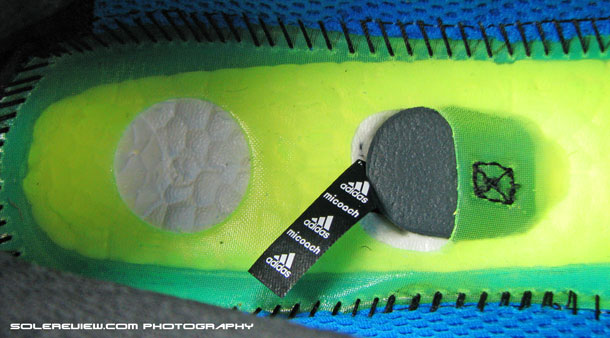
Use of innovative, see-through filmic strobel. Heel cut-out under insole for better feel, and ‘micoach’ foot-pod cavity.
It feels noticeably soft at slow speeds, yet it is underscored by an overbearing springy sensation. Pick up pace, and the ride comes through as responsive without any ’sink-in’ delay. What’s also impressive is the smooth weight transfer and loading – the midsole of the Energy Boost 2 is a singular, near heel-to-toe unit of Infinergy foam. The consequence of which is a uniform and consistent cushioning feel from rear to front. The outsole also sits low and flat with a ‘lip’ extending beneath the heel, so that also helps in better first contact with the running surface.
Ground feel or feedback is slightly isolated, but then we guess that’s the job better done by the Adizero Adios Boost. There’s a line of coloured EVA (Ethylene Vinyl Acetate) foam just beneath the upper, and you might mistake it for a layer between the foot and Boost midsole. The coloured line is simply a rim surrounding the upper, and all that separates the bottom of the foot is a soft, contoured sockliner and a transparent film through which Boost is visible. There’s also a small circular cutout in the rear foot, just below the heel. This dials up the cushioning level in that area. The transparent film (under the sockliner) in the forefoot is thinner than in the back, allowing the front to feel more cushioning and flexibility. We haven’t seen this type of strobel execution before, so that’s something new in addition to the Boost technology.
The sockliner is a contoured, drop-in piece of foamy softness. The shape flares upwards beneath the arch, helping support it, and has a friction free top cloth. Lift the left insole, and there’s a MiCoach cavity, where there’s space to pop in the transmitter foot-pod.
In a first for any midsole foam, we observed zero compression line or creases on the wall even after multiple runs, and that points out the material’s resilience and high resistance to deformation. This means, as long as the outsole and upper stay put, the shoe should lose none of its cushioning properties – the idea itself sounds wonderfully remarkable. This also tosses out of the window the oft used recommendation of replacing your shoe every 400 miles. In that regard, the Adidas Energy Boost 2 seems to be holding up well, with no signs of wear on the outsole – yet.
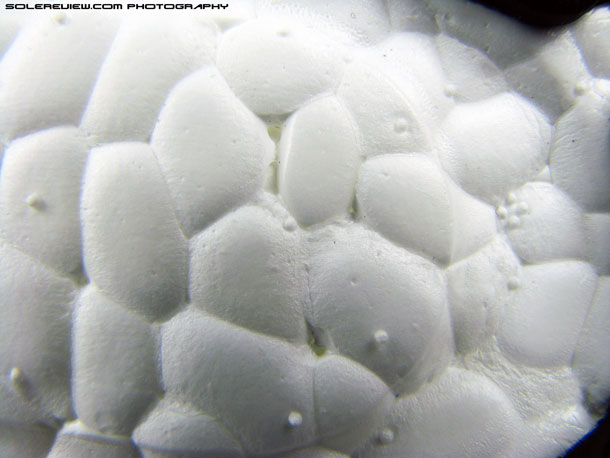
The Infinergy foam beads look like Marshmallows. Small foam ‘nipples’ show that beads were first individually molded and then steamed together.
A close-up of the midsole shows how individual Infinergy beads bond together; and when light is passed through, the midsole illuminates with a faint glow. This just shows the how expanded (low density) the TPU Infinergy foam is, and one of the reasons behind responsive cushioning. The brand and BASF claim the Boost to be extremely temperature resistant with little loss in its cushioning properties over temperature extremes, but we haven’t tested it in that aspect yet. From what we know of TPU, the Boost will certainly fare better than any other EVA foam available. We’ll post an update in case we have the opportunity to put the Boost to a weather extremity test.
Stability in the Energy Boost 2 comes from use of the plastic ’Torsion’ plate underneath the midsole, which sits low to the ground. The plate used in the Energy Boost is visible only in the mid foot, but it extends into a fork covering the sides of the forefoot, with a medial extension forming a stability levee under the rear-foot. The toe spring is quite high, and when combined with the Torsion ‘fingers’ underneath the forefoot, results in a smooth roll during toe-off’s. It does so by simulating a rocker motion while keeping weight distribution in a straight line.
The upper is very similar to last year’s Energy Boost, using what Adidas calls the ’Techfit’ construction. The upper fabric is a thick, spandex-like layer with plenty of stretch and printed details on its surface. The fit is tight, almost akin to a compression sock and there’s no open room at all. The toe box is also very low and pins the forefoot down to the sockliner, resulting in a heightened cushioned feel underneath. The fit is absolutely true to size (but need to half size up from Brooks or Nike due to conversion difference) with no extra room at all. Given the nature of the upper, runners would have to up-size half to one full size depending on their foot anatomy. Otherwise your forefoot or toes might rest uneasy.
The mid-foot is a different story though.
The 2013 Energy Boost featured mid-foot panels made of synthetic leather, but the 2014 Energy Boost 2 swaps those with a rigid plastic cage. The original Energy Boost already had a tight mid foot, and use of inflexible plastic on the 2014 model lends it all the subtlety of an under-bust corset. When worn with sports socks, pressure around the waist of the foot is borderline uncomfortable. What’s worse, this is not a break-in malady, but more a permanent one. The plastic panels don’t stretch out, and the feel stands in stark contrast to rest of the upper. It feels hard around the foot, and we certainly question the need for over constructing the Energy Boost 2 upper. The existing gusseted tongue set-up along with soft synthetic leather panels would have managed just fine.
Consequently, the Adidas Energy Boost 2 will come across as unusually tight unless worn with thin socks or without them. Barefoot running in the Energy Boost 2 can be done, though pressure from the plastic mid-foot panels might not agree with everyone. There is a strong sensation of something hard hugging the side of the foot. We do hope Adidas decides to tone down the next version of Energy Boost’s mid-foot.
The collar fit is a slight improvement over previous generation Energy Boost, backed by the change of material from an open structured air mesh to a fabric with greater density. It is also supported by the layer of fused plastic extending from the mid-foot cage; what worked against mid-foot fit works in favour of the collar. The molded plastic structure adds more than just aesthetic value in the rear-foot area, giving support and grip around the foot. Padding is comfortably compact, and gently swaddles the ankle area.
Reflectivity comes from the Adidas logo and array of dots on the heel, which illuminate when bathed in light. The execution is quite subtle. Unlike traditional reflective elements which are easily recognised by their shiny, silver surface, the Adidas logo looks like an ordinary layer. You are likely to mistake the Energy Boost 2 as a shoe with no night-time visibility, but as seen in the photograph above, that’s not the case.
The Boost platform has been marketed as a ‘game changer’ by Adidas, and for once, it is indeed so. A rarity where exaggerated marketing claims are becoming increasingly commonplace. But here the benefits are real and tangible.
There’s no taking away the fact the Boost foam just whops every other foam based cushioning in the market today, and should set-up sustained success for Adidas. The new technology magically delivers a perfect balance of softness and responsiveness, and is highly resistant to bottoming out – if that is not footwear utopia, what is. But they better watch out, because if this patent filing is anything to go by, brands like Nike could soon be snapping at their heels, and quite literally so.
The brand has high hopes for the Boost platform, with plans for 14 models by end of 2014, and a target of selling 15 million Boost featuring shoes by 2015. Considering that they sold 1.5 million pairs in 2013 alone with just three models (Energy Boost, Sonic and Adizero Boost), they should have little problem achieving their lofty ambitions.
The Germans have their magic potion. Endlich, like they say in Deutsch.
PS: Energy Boost 2.0 ESM is another version with a breathable stretch mesh, while the Energy Boost ATR has a water resistant upper and a gripper outsole. We had plans of reviewing the EB 2 ESM, but had to drop it due to time constraints.
(Note: Solereview paid full US retail price for the shoe reviewed)


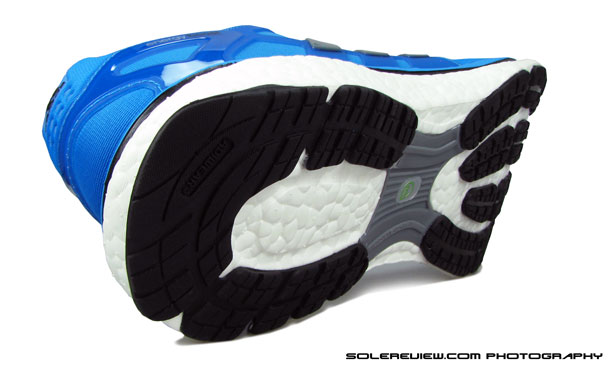
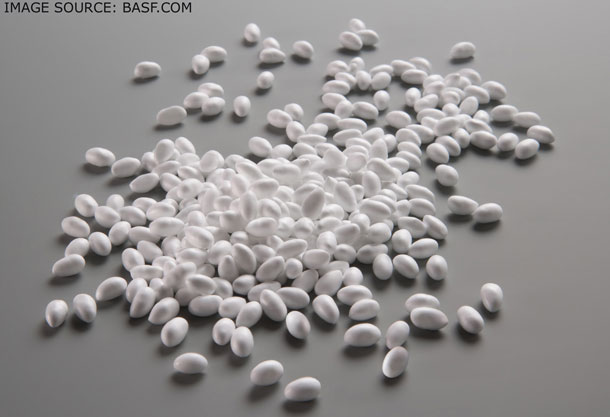
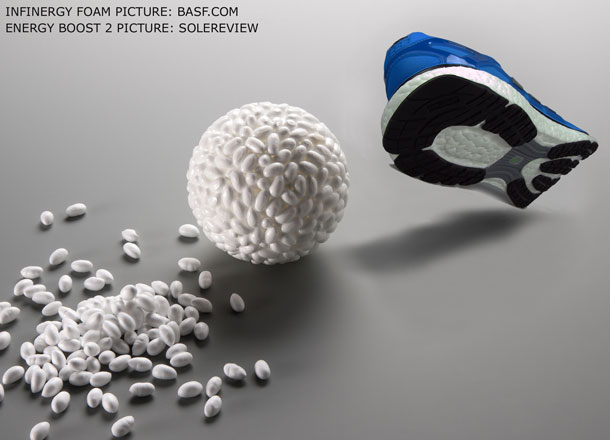
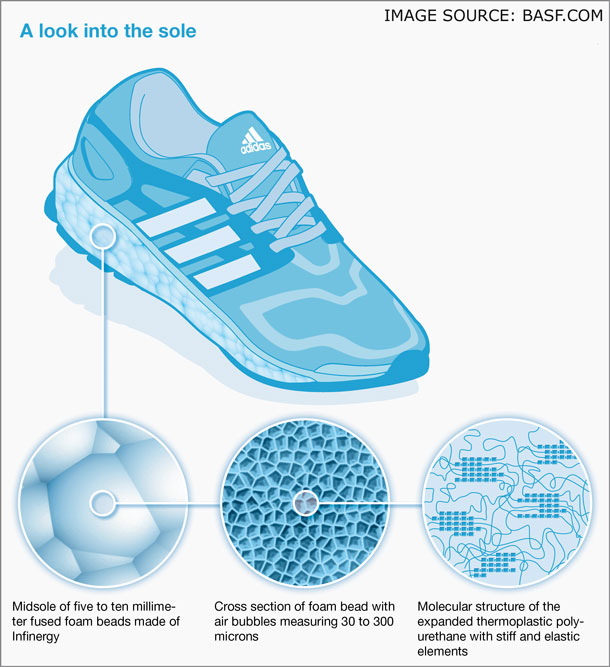
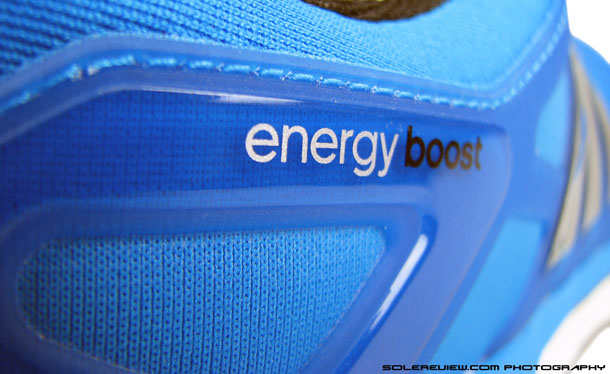
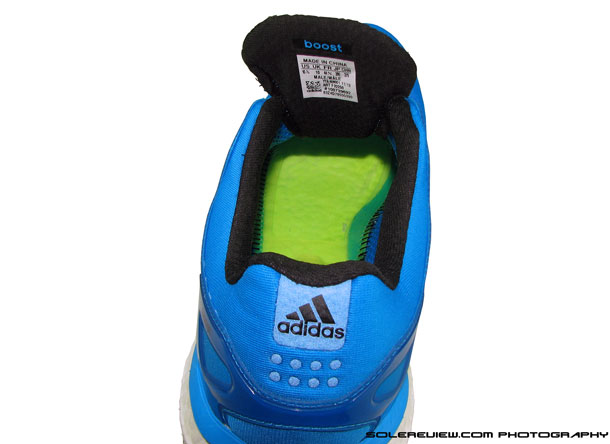
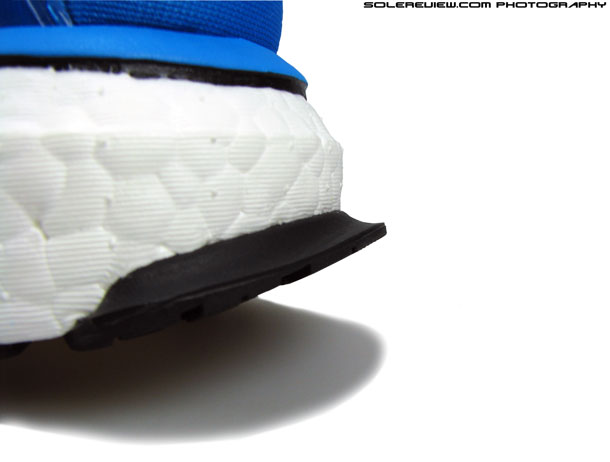
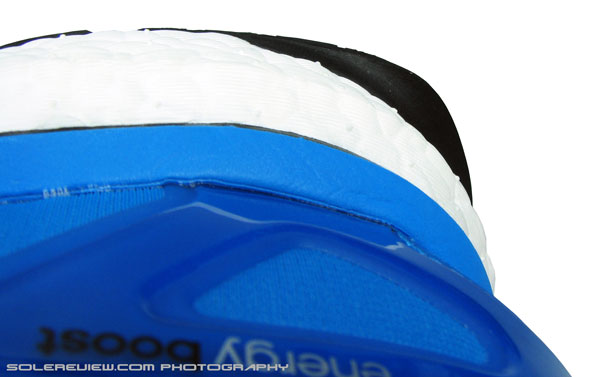
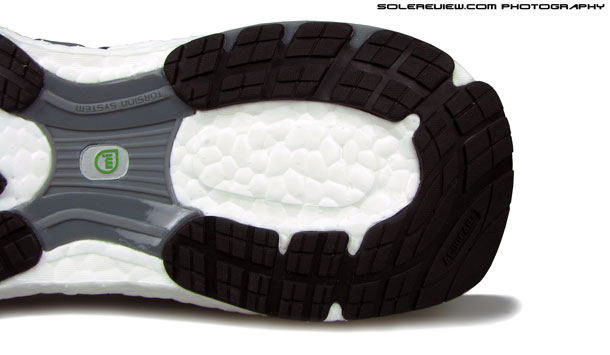
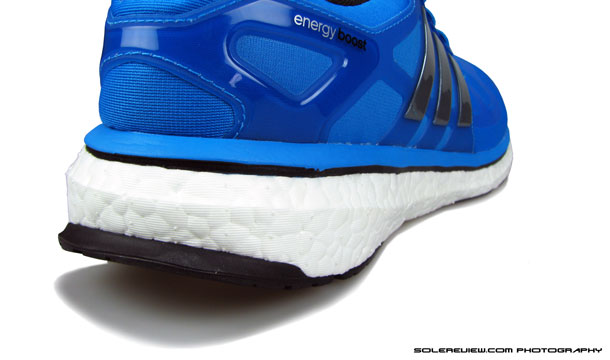
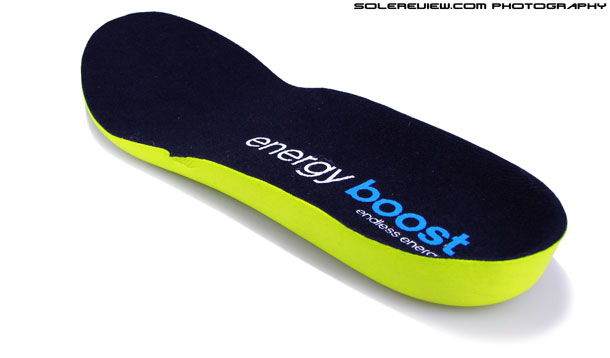
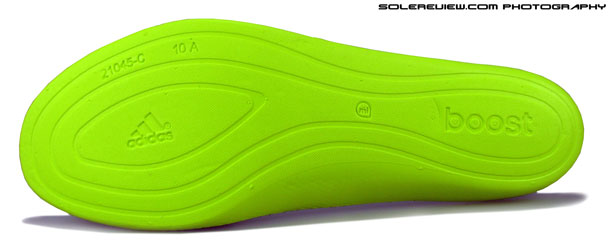
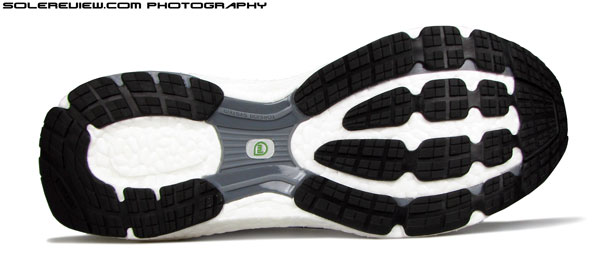
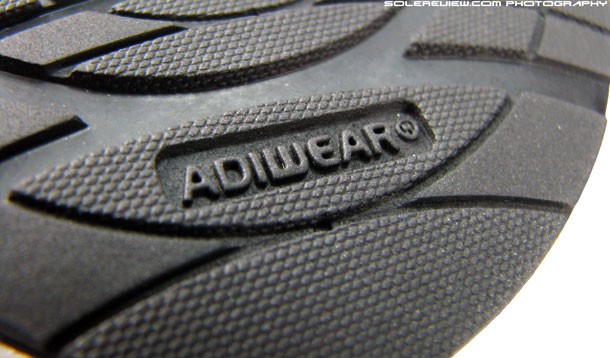
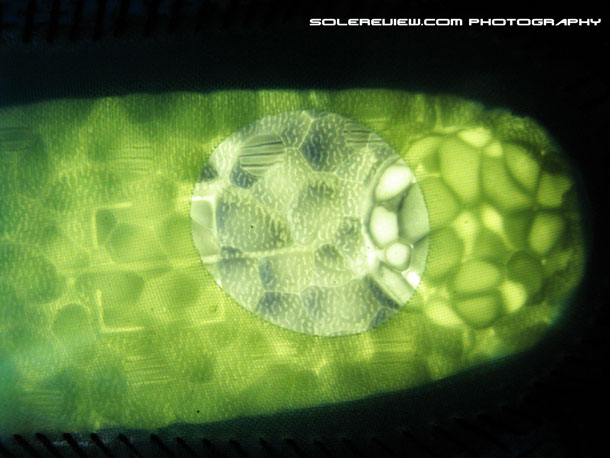
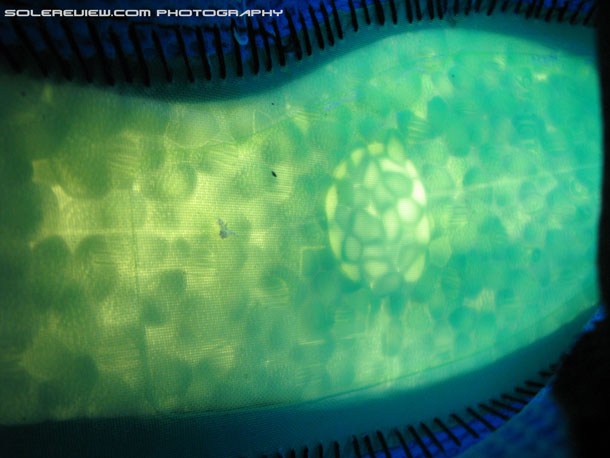
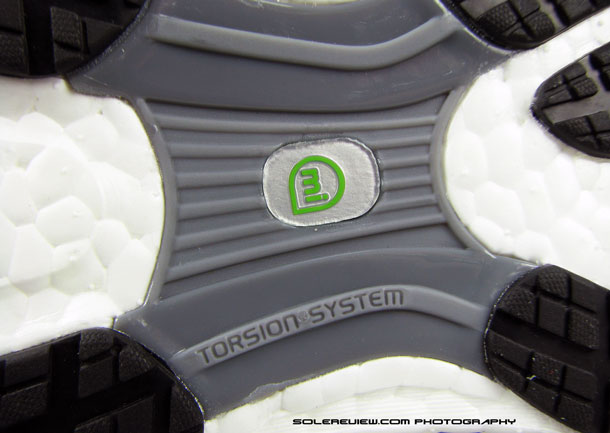
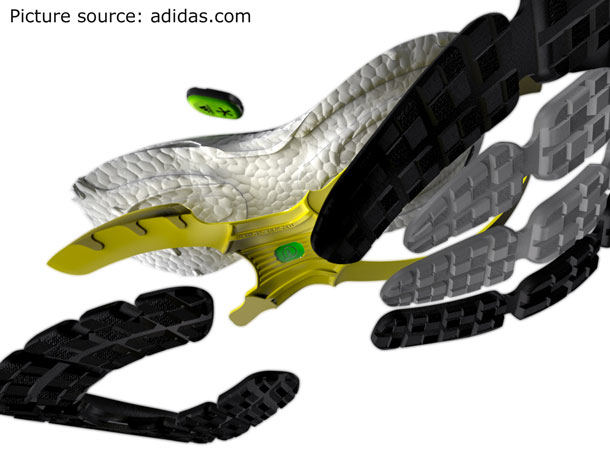
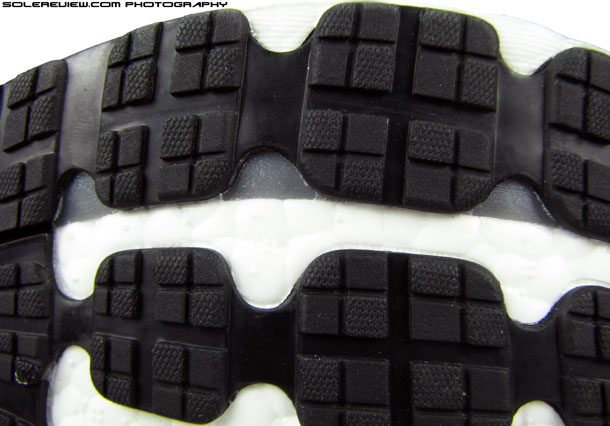
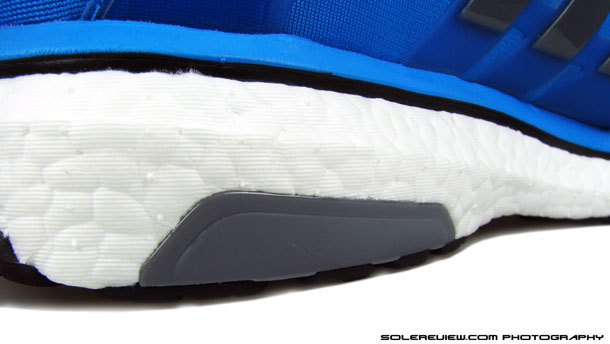
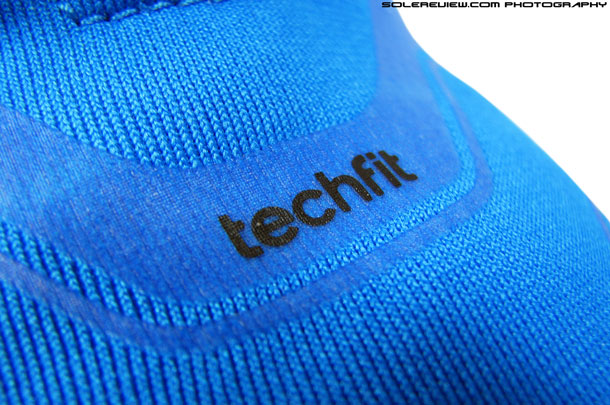
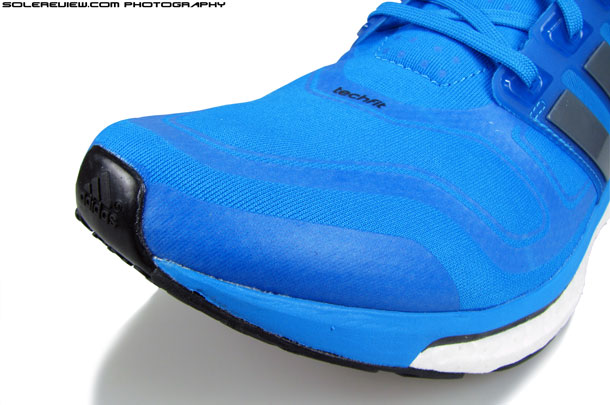
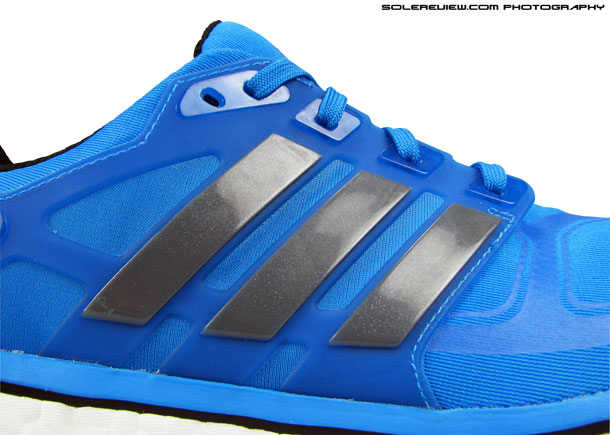
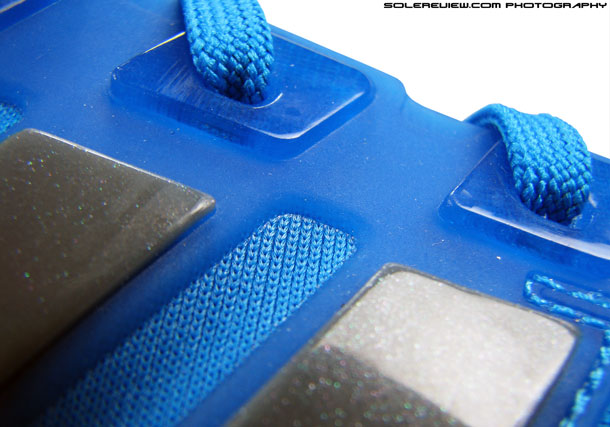
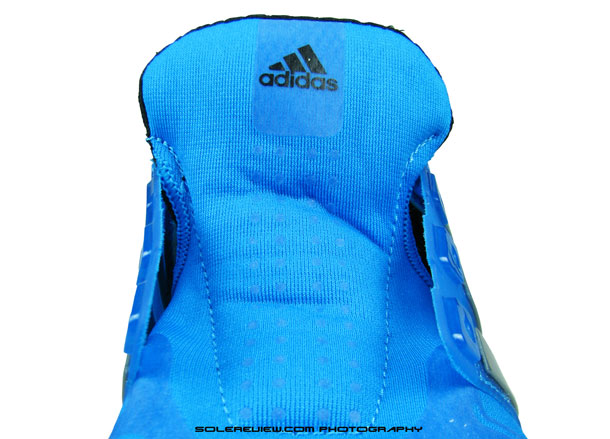
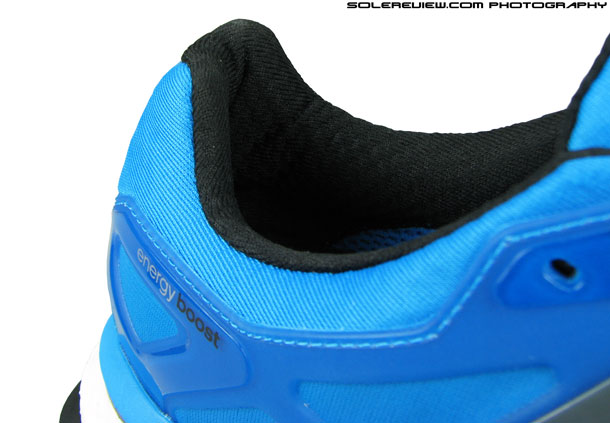
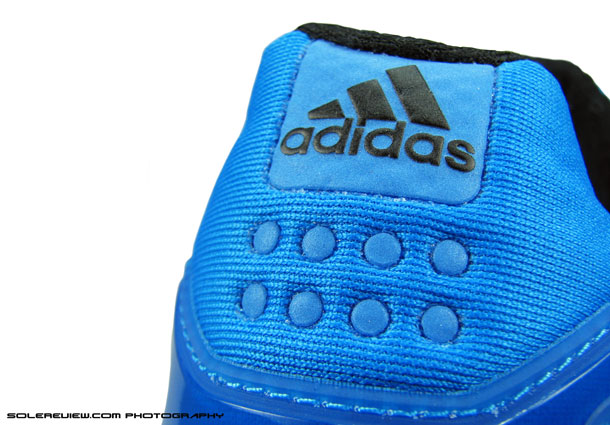
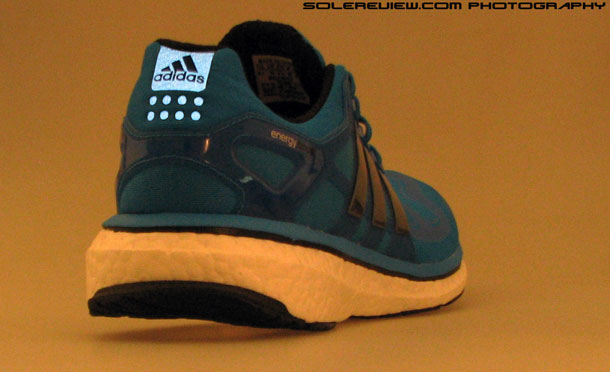
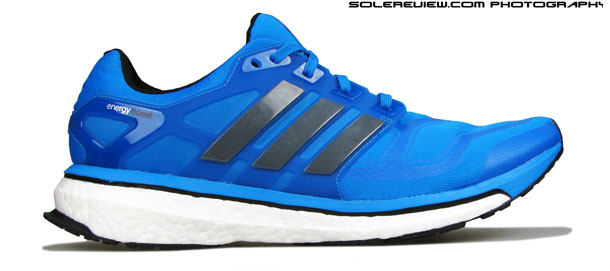
304 comments
Great review. I agree with most of what you wrote here, however, I actually think that the Energy Boost 2.0 fits better than the 1.0. Version 2.0 fits much more true to size, and the upper on the new model is much more plush. One of the big problems with the original Energy Boost was that the lacing system seemed to create pressure points on the foot during a run. With the updated upper, this doesn’t seem to be a problem anymore. If I had to guess, I’d wager that because the new techfit upper isn’t quite as stretchy, adidas had to go with a plastic cage to hold the foot in place. Overall, though, I thought version 2.0 was a great update. Adidas kept the best part of the shoe (the sole) and modified the upper, which seemed to be a point of contention for some people. The new shoe looks better, too. I’d be interested to hear what other runners have experienced.
Thank you for the insightful comment.
We feel that while the original Energy Boost had more top down pressure, the second version seems to move it to the sides, albeit in a much more spread out manner. That said, difference in foot anatomy will lead to slightly varying opinions -so thank you for voicing your feedback. We are also keen to know how the shoes work for different runners.
That said, we still see the Energy Boost 2.0 as a great shoe, and we have backed that sentiment with our high overall rating. Since we allocate only 22% (weighted average) to fit in our scoring methodology, it keeps one attribute from adversely dragging down the entire score, which is unfair. Because we know that what works for us (or not) during our weartest might be not be necessarily true for someone else reading the review.
Hi, I’d like to know what are the shoes that are comparable with the Adidas in term of the amount of cushion, specifically the amount of cushion perceived during the actual runnning. I’ve tried the Supernova Glide Boost 6, but they were too firm and with very few cushioning.
From what we’ve worn so far, the Adistar Boost M comes close to Energy Boost cushioning. The ride feels different though, because of the shear inducing heel ‘formotion’ cushioning, and the inner midsole is slightly firm due to EVA post. The Supernova Glide 6 has plenty of Boost, but comparatively feels less cushioned due to the non-yielding strobel (cloth below the insole) and a thinner midsole.
Our speculation is that Rocket Boost and Pure Boost should match up or exceed Energy Boost cushioning, but we haven’t wear tested these two shoes yet – hence unable to provide you with specifics.
Hi, thanks for the great reviews that I found here. I’m really pleased with the extensiveness of the reviews and the attention to detail!
I have a question. I’m now running with the Nike Zoom Vomero 3 shoes, and I really like the cushion of the shoes. It feels like running on air. But I think I need to replace them, given the decrease in cushion and the pain I start to develop in my left knee after running for 30 minutes, something I did not have when I bought the shoes.
So I was thinking of buying the new Vomero 9 shoes, but seems like they’re not at the same level as the 3 series. When reading the reviews here carefully, it seems to me that I personally have two choices:
1. the more affordable Nike PEGASUS 30+ shoes
2. the more expensive Adidas Energy boost 2
What would you recommend to me?
Thanks a lot!
Hi there! Thank you for the kind words and for visiting solereview :)
The Air Pegasus 31 is a good option, but the plushness/cushioning of the 2008 Vomero 3 can only be matched by the 2013 Asics Gel Nimbus 15, which has a slightly softer midsole than the Vomero 3. The Energy Boost 2 is a great shoe but the upper is very compressive – very different from how the Vomero 3 feels.
Try both (Pegasus+Nimbus) in the store and see what suits you better. Do let us know once you buy the shoes and have a chance to run in them..
Hi there. Firstly i would like to say that your shoe reviews are the best I’ve ever read, keep them coming.
Secondly, i’ve been looking for a pair of running shoes for a couple of weeks now. I only started running in December last year and have since got into it a lot and I now want to invest in a better pair of running shoes since the ones I got originally were cheap and aren’t really working for me. I’m torn between the entry level minimalist design that the Nike free 5.0 offers and the Adidas boost 2. I know bother of them offer quite different experiences so I was wondering what you thought. I would describe myself as a midsole striker and run at a reasonable quick pace when I do run which is no less then three times a week. However I never run much more than 5 miles.
Sorry, I know all that is a bit vague so any advice you could give me is appreciated.
Thanks for your time,
James.
Hi James – thank you for the compliment. It means a lot to us, the kind of thing which keeps us going!
Instead of giving you a short answer, we’d like to list down the pro and cons for both shoes (in your comment’s context). Hopefully that should be of some help. If you still need to bounce off additional thoughts, please feel free to do so.
Free 5.0 – Pros:
Lightweight
Flexible
Roomy upper
Well ventilated
Great rear-foot to toe transition
$100 price
Free 5.0 – Cons:
There’s a seam in the forefoot (see our review) which could be a potential fit issue.
Lower level of cushioning (vs Boost)
Low outsole durability due to less rubber
Traps debris with a vengeance.
Adidas Energy Boost – Pros:
Responsive, long lasting cushioning.
Snug upper fit, true to size
Potentially higher durability – full rubber outsole
Better traction
Works with pace runs.
Adidas Energy Boost Cons:
The midfoot might be too snug for some.
Upper runs warmer than the Free.
Expensive at $160
Salaam Alaikoum.
First, let me start by being redundant and reiterating what most of the people
have already stated which is obviously abundantly clear, YOUR WEBSITE IS
AWESOME! No sugar coating. No appeasing this brand or that
brand. Very thorough information from the perspective the reader is
looking for. Clearly you are one of us and understand what we really want
to know. We want to know how it feels, how it performs, and how it
compares to previous models as well as other models in the same category.
But it doesn’t stop there. You’re level of industry insight comes through
in each of your reviews. Be it how you describe “sacrificing speed
for cushion” in the review of the Pegasus 31, or the tech history lesson
in the review of the Adidas Boost 2. Thank
you for the candidly unbiased and most useful reviews. I happen to stumble on
your site while doing a review search for the Vomero 9; I’ll come to that in a
minute. After reading several of your reviews I can honestly state I have
to go no further in the future then your page for the insight I require to make
an informative and wise choice. At the very least I can narrow down my
options and then go to the store and do a fit test after reading your
reviews. Please keep up the good work. Inshallah you guys continue
to help us for years to come.
Second, as I stated I was looking for an honest review from someone that had
worn the Vomero 9. After reading you review and learning that literally
nothing had changed, sole wise that is, I took you recommendation and decided
on the discounted Vomero 8.
Now here is my situation. I need the most plus cushioned ride I can get. I don’t mind getting the previous (last
years) model if it does the job, plus who doesn’t like to save a few dollars.
At 42 I have had multiple surgeries and injuries on my knees and ankles from wear
and tear of decades of sports; running, basketball, snowboarding, roller-blade…etc.
The list goes on and on. This is why I need shoes that provide the joints
in my legs need as much relief as possible.
I still enjoy exercise to stay in shape although smarter now through
better training and equipment. The latter being good shoes. After
being inactive for 2 years due to the two job changes and three residence moves
I am ready to start exercising again but I need some good shoes.
The last two pair of running shoes I owned was the Vomero 5 and Pegasus
27. I purchased the Vomero based on a review stating that it had great
cushioning. The Pegasus because I knew it was a good all-rounder.
Immediately when I wore the Vomero I was pleased by the plush ride. I had
never felt anything like this in a running shoe before, the only other show
that came close was the Air Tuned Max from 1999 (in Saturn Red, wow, I still
remember the name of the color way). By the way I am a Nike loyalist but
have on a rare occasion purchased an Asics and a Reebok (the latter regrettably),
but I always gravitate back to Nike. Now back to the Vomero 5. When
I first wore them I actually had to get use to running in them. It
literally felt as if I had a compressed pillow under each of my feet and it
felt great! I know this is type of shoe is not for everyone but given my
history this is exactly what I desperately needed. After a few months I
ordered the Pegasus 27 so that I could have an alternating shoe to reduce wear
on the Vomero 5. The Pegasus 27 was firm at first and needed several
months of break-in to reach the cushion and give level I liked, although not to
the same level as the Vomero 5. I was a
little surprised it took so long to break in but afterwards realized this was
due to only running in them once or twice a week. I just enjoyed running in the Vomero 5 so much
more
Now back to present.
After further reading on your website of the Vomero 8 and learning that
it is nowhere as cushioned as prior iterations I am left with the dilemma of
having to purchase something different.
I then started to read you review on the Adidas Boost 2 and was excited,
especially with the resiliency potential of not losing, or very minimal loss,
of cushioning. Then I came across the
section of the review where you critic the mid-foot cage and it turned me
off. I think I’ll have to do the fit
test in the store to see how bad it is for me.
I do have one concern that I would like to address and get your opinion regarding
the Boost 2. The outsole seems very
thin, thinner then I have seen on any other shoe I have owned. So my question is how long do you think this
will last from frequent use, 3 – 4 days a week running, about 3 miles each
time? It seems to me that Adidas needed
to ensure you would have to buy another pair of shoes. Since the cushioning seems to be so resilient
and durable they had to make sure something else would give. What do you think? Is this a fair assessment from me?
So, if the Boost is not the way to go for me, possibly
because of the mid-cage, then what do you recommend? Remember max cushioning. By the way I have a new pair of LunarEclipse
4 that I purchased about 4 weeks ago and I use them casually for walking around
to the mall and such. I didn’t want to use
them for exercise because I wanted to keep them clean so I could continue to
use them casually. You see I live in the
Middle East and it tends to get very dusty outside. So after a few times running your shoes are covered
in a layer of dust. However I am tempted
to run in the LunarEclipse 4 maybe once or twice to see if maybe they would be
an alternative. Although just from
walking in the LunarEclipse 4 I get the sensation that they would not provide
the level of cushioning I need. Maybe
that will be a totally different feeling upon full force foot strike during
running. What do you think? Should I try?
I ask because you ran in the LunarEclipse and can give me a good
feedback with regard to the cushion comparison to Vomero, preferably the Vomero
5 if you ever ran in those.
Lastly, I wanted to request if you could add an info section
on the site, like and A, B, C, to athletic shoes. Something that explains height drop; or speed
vs. cushioning, as you did the Pegasus 31 review; types of shoes, support,
cushion, etc., and then lists those various shoes under their type to
facilitate search of reviews. This last
recommendation would be really useful, especially as time goes by and the list
of reviews grows.
I close saying thank you for all the work you put in. I look forward to your reply and your future
reviews.
Sincerely and Appreciative,
Rafael a.k.a. Tariq
Dear Tariq,
First off, thank you for the extremely kind words and detailed note. Solereview was started with the purpose of providing unbiased reviews, and we try to achieve that objective with every review we publish. We’re pleased to know that you find them useful!
We’ll try and address your comment in different sections so that we cover everything:
a) The Vomero 8 and 9 are built on the same platform, so it makes sense to go for the 8 at a lesser price. Good call on your choice.
b) The Vomero 5 was a plush, well cushioned shoe. Vomero 3 to 5 were the best of the lot, and it started going downhill from the 6. We wish we had bought 4 pairs of Vomero 3 back then!
c) The Energy Boost is nowhere as plush as the Vomero 5 when you compare only the upper. The Boost upper is comfortable, but more snug than plush, if you know what we mean. And the cushioning of the Boost is responsive, whereas the Vomero 5 was pillowy soft, as you’ve put it yourself.
d) Outsole durability depends on multiple factors like running surface, body weight, running style and ambient temperature. But as you’ve correctly observed, the outsole is thin on the Boost and it might potentially last lesser miles than another shoe with thicker rubber of the same type. Generally shoes tend to last in the range of 300-600 miles or so (excluding racing flats). But as we’ve mentioned, durability depends on other factors as well. The durability on the Boost should be good, but not great.
e) The Lunareclipse is far stiffer in ride than the Vomero 5, and as a result you will not get the same sensation. The upper is also not so plush as the Vomero 8. Right now, the plushest/most cushioned shoe we can think of is the Asics Gel Nimbus 15.
f) Thank you for your suggestion! We’ll certainly try to improve navigation once we have caught up on most reviews by September.
And Have you had the opportunity to visit our ‘list of performance reviews’ link? It has the list of all the shoes, and you can sort shoes by heel drop, motion control or neutral, or by weight. Here’s a link if you haven’t had a chance to see it yet:
https://www.solereview.com/list-of-performance-reviews/
Thanks again, and we do look forward to your visits again!
Best wishes,
Thanks for the quick reply.
I had briefly looked at the review list but lost all attention to detail because I didn’t even notice the other columns had such relevant and omportant information. By the way the navigation is good and the website is nice and clean. Presentation is concise but not short on detail. Good work again!
Can you please enlighten me? I Have never bothered to research what is meant by the “drop” and how it affects the shoe and runner. Apropos, a section with these types of explanations is what I meant by “ABC to athletic show”. I think it could be useful for runners seeking a bit more knowledge during their research of a good shoe.
A few of more questions.
· Regarding the Asics Gel Nimbus 15. I did a quick search and noticed that the Nimbus 16 is out already and your review for it is due on 01 AUG. With that said I’ll wait for the Nimbus 16 review before I commit to the 15.
· Sizing. I wear a size 9 in almost every Nike I have purchased, with the exception of the Vomero 5. It had such a spacious toe box that I had to go ½ size down to 8.5 for it to fit well. I recently did a fit test with the Vomero 9 and same results, the size 9 was too big, 8.5 fit well. From experience since you have worn both the Vomero and the Nimbus, how does your size translate from the former to the latter?
· I imagine that to remain unbiased and neutral you shouldn’t answer the next question. But I’ll ask anyway. Which websites do you recommend with good prices for purchasing shoes? You see we don’t have an Asics outlet here and I will have to order on-line.
By the way I actually work for the US Military, which means that I have access to the US postal services, which further means I can order from the US and not pay high shipping costs. In some cases free shipping if the website offers this within the US. Although I am in the Middle East since I am on a US Military Installation my address is considered a US address.
· How much difference is there in the plush cushion between the Nimbus 15 and the Vomero 8?
· Sind Sie aus Deutschland? I ask because you use of Deutsh in the Boost 2.0 review.
Rafael a.k.a. Tariq
Dear Tariq, thank you for the response. We’ll get back to you with details on your questions and update this comment within 24 hours.
Danke schön. Thanks to you I have decided to purchase the Nimbus 16. I was able to find it for $112 on Ebay with free shipping. The only thing left to do is to choose the color, decisions, decisions.
Rafael a.k.a Tariq
Good on you!
Please share your experience with the Nimbus 16 once you’ve got few miles on them.
Will do Inshallah. I’ll wait until after you have the N-16 review up so that I can post to it.
TC
Sorry, our Nimbus 16 review has been delayed way beyond our original dates. Time willing, we should be able to get to it this month. Hope you’re well!
Hi
I am just about to get new shoes, took me some time to decide which one will be the best choice for me. I was going to stick to asics ( nimbus) till I came across boosts, now almost made my mind and and will go for energy boost 2, but there is also energy boost 2 esm, which seems to have different upper, is esm more breathable , has anyone found bosts 2 abit sweaty?
Cheers
We did not find the original Boost 2 hot, but going by the looks of the ESM (we haven’t tried it yet), it appears to be more breathable and a little less tight.
Thanks for the reply. I decided to get ESMs, hopefully it was a good choice, first time buying running shoes without trying them on first, only because non of the shops in 60mi radious sells them.
You’re welcome. Do let us know how it goes for you, once you’ve got some miles on them!
what about the shoes Art? are they ok? size is true? i´m choosing yet.
Hi Art, how are you getting on with the ESM’s. I’m trying to decide between the snug fit of the boost 2 or the breathable ESM’s. I too am looking at switching from the Nimbus as feel they are to wide for me. Did you go up a size in the Adidas as they seem to be a bit smaller than the nimbus?
Hello,
Great site. I’ve been running in the Asics Nimbus 14 for over a year now. I returned to the heavily cushioned shoe after an unsuccessful couple of years with the Kinvara. Anyway, l like the Nimbus for its cushioning and breathability but I’m not entirely convinced that it’s “the shoe” so I’ve been eyeballing the Adidas Boost 2. In your opinion, are there specific qualities to recommend one over the other? I know this is probably too open ended a question but I couldn’t find a review for the new Nimbus on your site. Thanks for any help in this.
Peace
Thanks for the comment!
The Adidas Boost feels much more responsive than the Nimbus (version 15) and is lighter. On the flip side, the Boost upper feels more business like, with a tight mid-foot and snug forefoot which also run warmer relative to Asics.(though the new Boost ESM version seems to have more slack and ventilation).
We’ll be reviewing the Nimbus 16 later this month, please see our ‘upcoming reviews’ section for tentative dates.
Hi,
I’ve worn a number of shoes from my Free Run 2’s,Saucony Kinvara 3″s ,Adidas Adios 2, to my Brooks Ghost 6 and I was just wondering if this shoe would be good for me…
-I typically run 40 mpw at an average 6:50 pace
-I have and average arch and mid/fore foot strike( neutral/mild overpronator)
-113 lbs., 5″7
Anyway, I have worn the Nike Pegasus 30 and I hated it: the ride of the shoe terrible because it was too high heel-to-toe drop and it just felt unnatural. I felt like I was sinking into the ground with every step. I have heard the Adidas Energy Boost is soft but I was wondering if it has “the Pegasus type of feel” and does the big heel get in the way of your foot strike or is unnoticeable?
I really like the look and science behind this shoe but wasn’t sure if it was as good as everyone has been saying it is.
P.S. – I have really enjoyed your shoe reviews- Keep ‘Em Comin :)
The Energy Boost is nowhere as mushy as the Pegasus 30. The Boost midsole is much more responsive, and we think highly of the platform. No problems with the heel either.
Thanks for the detailed review. Very informative. Can you advise me if the “sizing up” applies to the female version? I have a pair on order from a local shop in my normal size. I ran on the treadmill briefly and while I really liked them, I thought about trying a larger size because of the way my toe outline was obvious against the top spandex portion of the shoes. Otherwise, they felt good and I didn’t request a size up because I thought the all-over fit would be too large and the spandex upper has give.
Good question. While we haven’t tested the female version, general tradition says that the men and women shoes are built on the same last (fit), so the overall fit behavior should be similar. As long as the tightness is on top of the toe and not ahead of it, you should be fine.
Thanks! I really appreciate the response. I’m thinking they are true to size for me but will know more in about a week.
I agree with the plastic support frame being a prison. I loved the cushion but went with the pegasus 31 only because of the plastic cage. It actually dug into my foot causing pressure points. But i do love the cushioning..
Appreciate the feedback.The shoe could have been much better with a synthetic midfoot wrap, like Supernova Glide 6 Boost.
Would you say these are the best overall shoe (trainer) that you have ever reviewed?
No, the Energy Boost 2 has its flaws, as we’ve mentioned above.
I feel like this shoe would be so much better if they lowered the heel-to-toe offset a little and added an extra shoe lace eyelet further down. Do you know if adidas will come out with a shoe like that description?-maintaining the tech fit upper but with an extra eyelet(adistar*best tech fit upper) and a lower platform(not a racing flat though)
-I know that sounds like too much too ask but I feel like that would be the perfect shoe ♥
Not sure of Adidas’ future plans with regards to the Boost line. So both of us will have to wait and watch :)
As far as the extra eyelet thing is concerned, the Sonic Boost did a great job last year with that.
Hello, i’m a heavy guy, with a 125 kg, and cushioning is the only thing that matters to me.
By your experience, which are the softest, most comfortable running shoes that you’ve tried?
Please mention a few choices, thanks :)
And by the way, great reviews, I enjoyed reading them.
We were a big fan of the 2008 Nike Zoom Vomero 3, which was one of the first shoes we reviewed on this website six years ago. But since none of us can time travel (yet), here are some modern day alternatives:
1) Asics Gel Nimbus 15 (last year’s model, but still available)
2) Adidas Adistar Boost (our review up later this month)
3) Brooks Transcend (it doesn’t feel as cushioned, but we liked the consistent spread of padding)
4) Nike Pegasus 31
Hi,
I’m a high school cross country runner. I run about 30 miles per week, mostly on paved bike paths. Would you recommend this shoe to me? Right now, I’m running wearing the Nike Lunarglike Flyknit 1+ shoes. Before, I wore the Nike 3.0 V5. I’m looking for something in between: a running shoe that’s responsive and somewhat quick, but still provides some support.
Thanks
The Energy Boost will do ok, but also consider the Glide 6 Boost and Boston Boost.
Energy Boost is one of the first 100 shoes to cross finish line of NYC 2013 Marathon. The result is 2:22 (~3:20 per km). I guess, the guy did non know that his shoes should be used only for slow and recovery runs. ;-)
Well, people have run marathons in a pair of Crocs Sandals too.
Thanks for reply. But I wonder anyway: most of the shoes reviewed are intended “for long and recovery runs”. Does it mean that they are not suitable for weekly interval training or tempo runs? For example, should one run intervals 5×1000 in Energy Boost or, say, 10 km tempo in Pegasus?
That line is a generalisation of the shoe’s behavior – you can do intervals in the Boost or Tempo’s in the Pegasus, it is just that they do not feel as efficient as say, a purpose built shoe.
We also tag a lot of shoes as ‘all runs except trail/bad weather’, which aligns with what you just said.
Hi, I recently got a pair of these shoes, the ESM version (stretchier mesh in the upper with more breathability), and couldn’t be happier. I’m currently training for my first marathon ever. I’m a heavy runner at 95kg and was looking for something that could carry me over long distances with lots of confort. I was trying to decide between Nike Vomero 9 or Pegasus 31, Asics Nimbus 16 or Kayano 20 and Adidas Energy Boost 2.0 ESM. I tried them all at the same store and the Adidas immediately felt softer and more comfortable than any of the others, especially in the heel area.
I took them out for a run this morning, looking to do 10 or 12km and ended up running 26km, my longest training session ever! The shoes feel extremely soft when the foot hits the ground. The mid-foot is tight, slightly uncomfortable in the beginning, but the feeling disappeared after 2 or 3kms. I used a deliberately slow rhythm for the first 10 kms (around 6 mins per km) to give time for the shoes to adapt to my feet. I picked up the pace a bit (to about 5:30 mins per km) for the remainder of the run and immediately felt a spring-like sensation pulling forward. It seemed like the faster I ran, the more my feet bounced off the ground. For the last 5 kms (i.e. after completing the equivalent of a half-marathon) I still felt great and was doing 5:20 mins per km!
just a few more comments. The mid-foot feels very snug, tight even, but except for the first 2 or 3 kms, I did not find it uncomfortable. The front part of the shoe is very comfortable, but I did have to upsize half a size from my usual. My toes had enough space to move around and I did not get purple toe nails or blisters as I had experienced with other shoes. No blisters under the arches either. I think I found the perfect shoe for my upcoming events!
Thank you Solereview, not only for the extremely thorough analysis you put into all your reviews, but also for giving me great tips as to the brands/models of shoes that in your opinion would work best for my needs. Much appreciated! best regards, BC
Hi Bruno,
we’re pleased to hear about your experience. Appreciate your detailed feedback about the EB 2 ESM – this not only helps other readers, but also us – it is always good to hear multiple viewpoints. We try to put in a lot of detail, but the review is still based on the opinion of a select few.
Agree on what you said about the Boost. For once, this is not just marketing fluff but a material which delivers real world benefits and makes regular foam feel ancient.
Thanks for your thoughts on the upper fit; we’ll throw in a upper only review of the Energy Boost 2 ESM soon. Maybe end of September or early October.
Glad our suggestions were of some help! You’re welcome.
Hi! Just wanted to give you a quick update on my experience with the Energy Boost 2.0 ESM. After completing my first marathon ever one month ago (4:22), I just beat my all-time personal record on the half-marathon (1:44), shaving more than 5 minutes off my previous record from one year ago. The shoes feel great and although training plays an important role, I feel these shoes really help me achieve my objectives. My next goal will be finishing a marathon under 4 hours!
Thank you Bruno, for getting back with your feedback, appreciate it. And congratulations for completing your first 26.2 miler, and honestly speaking, 1:44 half is pretty respectable.
Glad to hear the shoes have worked out so well for you!
Considering the score of Nike Peasus 31, I’m about buy this shoe but the price in Nike strore near my place is around $130. Meanwhile Energy boost 2 is also around $130, and Adidas Supernova Glide 6 (same color as you review) is about $100. Still waiting your review for Adistar Boost (espesialy ESM type) & adizero primeknit boost because it doesn’t have “the plastic midfood cage” that make abit uncomfort when I try the Energy boost 2 at the store.
Thanks. It seems unlikely (at this time) that we will review the Adistar Boost – it was previously scheduled but now has been removed. However, we will be reviewing the PureBoost Reveal, if that helps at all.
oo.. I see, that’s why I thought I’ve seen the schedule of Adistar Boost on your schedule. Well…, thanks anyway because all of your review give me so much knowledge and pleasure to read. Can’t wait for another review.
Thanks! By the way, the PureBoost is interesting… up in October first week, so that might be some consolation!
Hi I’m a high school middle distance athlete doing about 50-60 km a week in the winter. I’m struggling to choose between energy boost 2.0 and pegasus 31, any suggestions please?
What’s your footwear history – what shoes have you liked or disliked in the past? What do you look for in a shoe?
I want a shoe that can do shorter stuff like 400-2000m repeats and something I can do long runs (10-15 km)in. I’ve wore pegasus 30 which was nice, but I always felt like I couldn’t “pick it up” at the end of sessions and cross country races with it.
In that case, the Energy Boost 2 might be a good choice. Do try both before buying – the Techfit and ESM upper versions.
Im a college runner and a bit heavier 6’1″ at 72 kg im a midfoot striker running 60-65 mpw and looking for something really durable and lite.I was looking at running warehouse and they said the forefoot is rather thin at 16mm. I’ve been fighting with plantar fasciitis and want a shoe that has decent support that doesn’t flex very much. Would the Boost 2 be a good fit for me without hurting my archs. I’ve ran a lot in the Pegasus and loved them but they really irritate my arch because they flex to much. would you suggest the boost for me?
The Boost is still soft, have you given the Zoom Elite 7 a try? Much firmer ride than the Pegasus, and stiffer overall. Got a responsive Zoom air bag in the forefoot which might complement your footstrike too.
I have the same exact problem: Weak arches and they sore after long runs over 15k. Currently running on Brooks GTS14 and looking for an alternative. From your reviews, I see Zoom Structure 18 scores higher in Sole Arch Support category more than any other shoes. Should I try the ZS18 over this new Boost tech for better arch support? Thanks!
You noted correctly – the Zoom Structure 18 has far better arch support than the Energy Boost, so definitely worth a try.
First of all I should stated that I’m impressed by the excellent review
Moreover, I bought the boost 2.0 shoes May 2014. I have run with them 1200 km, mostly on asphalt bike roads. The shoes look like new, but tell me what do you think is the mileage of shoe? In order not to start feeling pressure in my lower body. At 2000 km, I should by new pair?
Thank you in advance
/Ikaros
Hi – the Boost midsole does not lose its cushioning properties, so buy a pair of new shoes only when the rubber outsole or a part of it is completely worn out, and you can see the white midsole.
1200 kms is very impressive mileage!
Hej, thanks for the prompt response
This morning after my work commuting, felt my soleus a bit sore. Thought maybe the shoes are asking for replacement. Then saw your post. Maybe, my legs are tired :)
Safe
After 1300kms? Yes, they (legs) sure need some rest!
Hi guys, thank you for your detailed review! Im a marathon runner and Ive been using Asics Nimbus since 2010 but recently switched to Asics Cumulus due to price. Comfort and shock absorption is most important to me and i have a high arch. Not so happy with Cumulus as I was with Nimbus, but how would you recommend/compare Asics Boost2 over the Nimbus? A number of guys in my running club is very happy with their Adidas boost shoes. I value your opinion.
In your question, we assume you’re referring to the Gel Nimbus 16. In that context, the Energy Boost is lighter, more cushioned (and responsive) and has a snugger upper feel, specially around the midfoot area. (Techfit or ESM).
If comfort and shock absorption are what you’re looking for, adidas EB-2 will do it better than the Asics.
I bought the Boos2 and Im very happy with them. It is not as soft as the Nimbus, but still adequate in the shock absorption department. It might ge my imagination, but they certainly feel faster than the Nimbus and the outsole is much tougher than Nimbus – 150km on them and barely any visible wear on the outsole.
Thanks for the feedback, and great to hear that!
Great review. I own the original Energy Boost and loved it. However, nearly 2 years later the sole lacks the same response and there’s a hole in the upper. Very close to getting the 2nd one. However, the main complaint for me in the boost was the price. $160 was always too much for a shoe. How does the boost 2.0 compare to the pegasus 31? The pegasus looks great (price wise too) but I was afraid i’d lose the responsiveness of the boost. I tend to heel strike more often than most. Does the pegaus have that same “push” when you strike the heel? The reviews said it was plushy; not sure what that meant haha.
The Pegasus heel is much softer, and perhaps that’s what the reviews meant by ‘plush’. It has some springback when you land on the heels, but falls short of what you’ll experience in the Boost.
Hello, Great review. I ran the past months with the Energy Boost 2 and was very satisfied. I switch between Energy Boost en Adistar Boost for my long runs. Next week I want to buy new Energt Boost Shoes. In the local running shop, I saw that they have Energy Boost 2.0 ESM and ATR. Do you know what the difference is between these two shoes? Thanks a lot for your answer!
Hi Maarten, the Energy Boost ESM (Engineered Stretch Mesh) has a stretch mesh which had a little more breathability than regular versions.
The ATR (All terrain) version is the same shoe as techfit version, but the upper has a thicker layer of printing which makes it warmer. The outsole is also new and different, it uses continental rubber with a more aggressive lug design. This improves the grip as compared to regular Energy Boosts.
Hope this helps!
I have been using the Adistar for 2 years now but have been having problems with my toes as the shoes were too small. I’m now looking at a 4.5 or even a 5. The Energy Boost does feel very nice (in a size 5) (my regular shoe size is a 3) but I’m not sure if it’s for long distance, max 21.1km, maybe the odd full marathon? Also, I’ve heard that the Adistar Boost is for stability ie, pronation or something like that, I’m a neutral runner, are they okay for me. I absolutely swear by my Adistar Boost, feels like wearing slippers.
You can do a full marathon in the Energy Boost as long as the snug fit doesn’t cause problems – that would depend on the compatibility between your foot shape and shoe.
If you’re wearing the Adistar Boost for sometime with no issues, then don’t worry about the pronation part, keep using them – regardless of the fact that you’re neutral.
Hi I would like to know about the differences between adios boost 2 and energy boost 2
The Energy Boost 2 is a cushioned trainer which can be used for daily runs. Has a lot more Boost foam (and hence overall cushioning) than the adios, which is meant for distance road racing. The adios is lighter, more breathable, yet less durable. It also fits snugger than Energy Boost.
Do u think that adios boost 2 would be more durable and softer than lunarglide? In this case, I would go for adios boost 2 for a cheaper shoe compare to energy boost 2
No, Adios scores lower on softness and durability than the Lunarglide 6. Instead, why not go for the Response Boost, non-Techfit version? Cheaper than the Energy and Adios, and same price as the Glide.
Thanks again for your fantastic reviews. I was torn between these Adidas and the Hoka Cliftons but a 50% discount on the Adidas was too much of an incentive. I doubt I could go wrong either way but I am lightweight and may not need all the cushioning from the Cliftons. If you had to pick between them, all things considered, which one do you prefer as a daily trainer?
Glad to hear you like our reviews!
We’d choose the adidas Energy Boost, given the same set of circumstances you’re under.
Hi,
First of all great reviews! I currently own a pair of non boost Adios, these I use for races, 10 to Marathon and they still have plenty of miles left before replacing, I’m also currently using the Boston 4 for tempo runs, intervals and weekend long runs, but to preserve the miles on these I’ve been looking at something for my long easy runs and maybe tempo running, would the EB2 fit the bill? The alternative I was looking at was the Asics ds-gl neutrals? My foot size in the Boston 4 is a UK9.5 so half a size up on my normal UK9, would the EB2 UK9 work or would I be better off with a UK9.5?
Regards,
Hi –
The EB2 looks like a good match for the need you’ve described. It might be safer to go with a 9.5, as the Energy Boost toe-box’s pretty shallow too.
Though it will be best to try them on first, that’ll give you a much better sense of sizing.
Hi I went to adidas store today and tried on the energy boost 2 and they felt great. I have two questions: 1. Does the ATR version have the torsion system for support? 2. Does the regular energy boost 2 have engineered mesh or is it only for ESM version?
Sorry for the delayed reply.
1) Yes, the ATR version has an identical torsion shank (as the Energy Boost 2 ESM/Techfit).
2) No, the regular Energy Boosts have a stretchy ‘Techfit’ non-ESM version,
Hi
Should I buy adidas Energy Boost 2.0 Esm over the adizer adios boost 2.0? I run 5k every 2 days. I’m not a professional but looking for stability and cushioning as I’m not very “light”.
It would be a good idea to pass the Adizero over and go for the Energy Boost. If you’re looking for more stability, the Supernova Sequence Boost is a great alternative.
https://www.solereview.com/adidas-supernova-sequence-7-boost-review/
I liked the feel of the shoes but the plastic mid foot cage was a deal killer. It’s mind boggling why they would take something as soft and flexible as the ESM and enclose it in hard plastic. I think I would have liked them.
Yes, that’s what we felt too. adidas tends to overbuild some of their shoes.
Im mind boggled on this one as well! Shocked really, at how quickly that cage rubs on the navicular bone, where was thier product teasing…. I brought mine online, after totally loving the original Energy Boost.
Hi. I loved these shoes, but four weeks of running in them and 160km was enough for my navicular bone. The thing is, that there is no protection between navicular bone and plastic midfoot cage, so it became to painful to further run with these shoes. I am kind of sad :´( , because otherwise I liked them very much.
I hope Adidas will resolve this hard (bone rubbing) plastic prison in the middle in a near future.
Hopefully, adidas should fix that – waiting for the Energy Boost 3.0 in 2015 to arrive.
I can’t decide which shoes to chose: Pegasus 31 or Lunarglide 6?
I worn Pegasus 30 till now, and I was thrilled over them, which means, that my feets require more cushioning. I’m prone to heel and Achilles pain in my left foot and I run 40-50 km/week.
I hope you can help me.
More cushioning? Pegasus 31 it is. Or Hoka Clifton if you want the cushiest of them all.
I actually like them very much because they are so narrow. I feel like I am running on clouds when I run in them! Two thumbs up from me!
The shoe works beautifully for those who can live with its narrow upper. Glad to hear that you love them!
Have you reviewed the Energy Boost 2.0 ESM ?
Sorry, not yet. Unlikely to do so as we’re pressed for time. The next Energy Boost we’ll review is the version 3.0 which releases early 2015.
Thanks
Hi. I am a severe over-pronator and currently using motion control and stability running shoes (Brooks Addiction 11 and New Balance 1260v4). I also have the Nike Structure 17 when I need to run faster than most days (less clunky). I store tried the Adistar Boost ESM and found it to be very friendly on my feet (no km yet). Then I read about the Sequence Boost 7 which gives more stability than the Adistar Boost ESM. I am from a country where shoes are never returned, period. Do you think the Sequence Boost 7 will be as effective as my existing pair of running shoes?
The Sequence is a great shoe – cushioning is on the firmer side, but very stable. But like most adidas, a little snug upfront.
Hi.
I am looking to find a good pair of running shoes for the London Marathon. I was looning at the Adidas Energy Boost 2 but am concerned about the tight fit reveiws I have read.
Do you think they would be suitable on the feet for 26 miles and not painful?
Hi – that completely depends on how your foot is shaped. If it is on the wider side, you might face problems. Otherwise a great shoe.
Also consider the newly released (limited for now) New Balance Fresh Foam Zante, adidas Boston Boost and Supernova Glide 6/7
Hi I have just read through the Lunarglide 6 Review as well as Energy boost and supernova. I found a new shoe in store today the Adidas Revenge Boost II. From these I have been in store and looking around for what is best for me, I need shoes that are going to be used for on road/pavement as well as some oval/dirt roads as I will be doing conditioning in them. I have a flat foot and normally run in sneakers. If I run for long distances I tend to strap my foot due to supination and rolling my ankles in rare occurrences.
My question is the adidas revenge boost 2 is a new shoe, and does not have a review from you guys nor many other websites, however, in Australia it is $40-50 cheaper then the lunarglide…. To me, both felt the same, Any idea what would be best suited for my case ?
Cheers :)
Can’t really offer much information on the Revenergy Boost, because as you pointed out, we haven’t gone over that yet.
In pictures, it looks good though. If it is 45-50 cheaper than LG6, then worth a shot, we’d say.
Firstly let me say I’m impressed with your review and the fact you actually respond to people. I bought the Energy Boost 2 about 4 months ago. About 2 months or 600km later and the rubber outsole at the rear had already worn through to the boost material. I weigh 58kg and most of my training is at about 6min/km, with intervals and tempo runs at between 4mins-4mins 15s/km. Now I think that’s a really short space of time for the rubber to wear through. The Nimbus 15 I ran with before were much harder wearing although I do like the feel of the Energy Boost 2. Is there something comparable to the Energy Boost 2 with boost foam with a thicker and harder wearing rubber?
Thank you for the comment, and happy to hear you like our review!
That is a tough one – the Boost is super responsive, so hard to find another (brand) shoe with the said requirements. The Adistar Boost has a thicker outsole, but only minutely so. Don’t think that’s going to make any difference from where you are right now.
We’re waiting for the Energy Boost 3.0 (2015) to show up in a month or two, so let’s see if there are any changes to the outsole thickness.
Another way is to just snag off-season colors really cheap, get more value for your money and live with the 600 km lifespan.
I love you reviews! I wonder if you could help me a little bit;
I’m looking for a light shoe that I can train and run a marathon with. One of the nicest shoes so far that I have run with in terms of cushioning/response was Nike Lunarelite+ (the model which I believe Nike at one point replaced Air Zoom Elite with, but has since discontinued) but the shoes were a bit too clunky and didn’t fit that well. I tried these Energy Boosts and I really liked the feel except the toe box was slightly too narrow for me, but that could have also been because the only size the store had was probably half a size too small. In the end I ended up asking them to order Adios Boos 2’s for me to try. But I have a bad feeling that the Adios’ won’t fit either, and I don’t know what I should try next. Is there a shoe in the adidas boost line that has the same or better ground feel than the energy boost, but also a wider toe box? Do you know if Adidas is planning on releasing more boost foam shoes in 2015 that could fit in this description or should I just start thinking about Zoom Elite 7’s or Zoom Streak 5’s for example.
Cheers!
If you were into the LunarElites, then perhaps the Saucony Kinvara 5 could also be part of your consideration set. The Energy Boosts are tight in the front, and so are the Adios and Bostons, latter slightly less so than Adios.
Adidas is releasing the Tempo Boost next month, but as we haven’t got our hands on them yet – don’t know how the fit is. Ditto for Energy Boost 3.0. Otherwise, as you have pointed out, shoes with roomier forefoot like the Streak 5.
The Nike Lunarlaunch is also very light and fits well, but coming from Lunarelites, the Launch will feel too soft for your taste.
That is just a different fabric on the upper, it is the same as Energy Boost 2.0. Refer to our Pure Boost Reveal review for details on that textile.
hi it was a detailed review about the energy booster 2. i tried supernova , response and energy booster as-well and am very much satisfied with the energy booster fit still i would like to get a suggestion which one to buy. my purpose is for daily running and for marathon.
We’d pick the Energy Boost 2.0 – just watch out the midfoot space, they tend to go super tight.
thanks for your valuable suggestion
I have been running in Asics Cumulus 16 till now and wanted another pair to rotate them. Based on your recommendation, I bought a pair of Adidas Energy Boost 2.0 ESM. Sizing is definitely an issue with these. I wear a UK-8 for my Asics and Nike, but had to buy UK-9 for Energy Boost (We don’t get half size up/ down in India). Hence, the shoe is slightly big and leaves a bigger gap at front of toes. I hope it isn’t an irritant when I have covered a few miles on my run.
The feel of that sole striking the ground and response is certainly good.
While a half upsize would have been ideal, given the circumstances, thicker running socks should help. One of the issues of going too big in a shoe is that transitions and toe-off’s start feeling sloppy. That, and blisters for some runners.
I’ve really fallen in love with your site and reviews recently. Thanks so much for all the work you put in. With that said, long question to follow :D
I’m currently training for the Boston Marathon with a goal of sub 2:50. I’m in a pair of Pegasus 30s that I have really enjoyed for almost all of my recent training. I’ve run two halves in the Pegasus with a most recent PR of 1:22:07. I’m a little over 200mi in my Pegasus and know that they won’t get me through my Boston training. Though I haven’t tried the P31, they’ve changed and I’ve decided to look into some other options to rotate into my workouts.
With all of that said, I’ve been looking at the Adidas boost line and hoping to pick up either the Energy Boost or the Glide Boost. So here goes two questions.
1) Could you share some thoughts on which shoe you think might be a good fit?
2) If I like the adidas, do you think it would be wise to pick up a pair of the Adios Boost or Boston Boost for faster workouts and race days?
Any thoughts or advice you have is much appreciated. Keep up the awesome reviews.
While you wait for Solereview to reply to your query, let me share my 2 cents about Nike Pegasus. 30 would feel much more spongy than 31 and probably isn’t a running shoe. 31 will feel far superior to 30 in every way and is a shoe that you should definitely consider.
There are other options, but I will limit my comment to this. If you were happy with 30, chances are that you will be delighted with 31. You can go for a lighter and less cushioned shoe for speed workouts and race day.
Thank you for the kind words! And yes, no problem at all with the question, which we’ll be happy to answer.
A goal of sub 2:50 is pretty awesome, so wish you the best in advance, and hope you top that! What was your qualifying time?
1) Coming from the Pegasus 30, you will like the Energy Boost’s cushioning, but not its restrictive nature of upper fit. In that context, would help to try the SGB 7, which has a more relaxed upper than EB-2. However, when compared to Pegasus 30, the toe box will feel shallower and overall ride slightly firmer, yet responsive.
2) We’d choose the Boston Boost over the two. Though whether you like the lower profile (well, the BB is not exactly so, but relatively speaking) shoe or not is purely subjective. For all you know, you might go back to running in SGB-7.
My BQ time was my first marathon ever, NYC 2013. My only goal was to break 3 and I ran a 2:59:39. My splits were actually pretty even except for mile 16. Not sure what happened there, haha. I’m hoping that I can shave at least 10 minutes off of that now that I know a little better what to expect and since Boston tends to be a faster course assuming I train for it.
I snagged a pair of Boston Boost on sale recently and they’ll be here next week. Going to try and rotate them in slowly to some faster, shorter runs and see how it feels. Hoping I can get comfortable to the point I can race in them.
I also ordered a pair of the EB2 and SGB7 today. I doubt I’ll keep both but looking forward to seeing how each feels compared to my Pegasus.
First marathon timing is impressive, and so are the splits! You’ll do well in Boston.
Look forward to hearing you feedback on all three shoes. It helps us, and will help others too!
I got the shoes in. I wear a 10 in Nike but needed to size up to a 10.5 in all the Adidas shoes. Not sure what it was but the energy boost didn’t feel right. I felt much more comfortable in the glide. Went for my first run in them tonight and loved it. Felt great the whole way through. There was plenty of cushion but my feet didn’t feel like they were sinking in to the ground.
I am still waiting to get the size 10.5 in the Boston boost but I think I’m really going to like them and can’t wait to try them on some fast runs.
Great to hear your positive feedback on the Glide, thought you’ll lean that way. And yes, you need to half size up on adidas compared to Nike’s, that’s something which we experienced too..
This comment is few days past, did you get a couple of quick ones in the BB?
Is this a mild stability shoe like the Lunarglide?
Nope. That would be the adidas Supernova Sequence 7 Boost.
How could you clean this shoe?? I have the orange model and it is starting to look dirty, any ideas of how should I clean them? Loved the review by the way
I have the orange also, I threw them in the washing machine, and let them airdry. Came out looking good as new!
You are kidding me mate! I have always been afraid of throw them to the washing machine, that is a piece of advice mate many thanks!
Yup! I’ve done it with many shoes…just do not put them in the dryer!
Just one thing mate, do you put any other clothes or something with them? Or just the shoe itself?
We won’t recommend throwing them into a washing machine.
We’d first use something like a Krud Kutter to clean the white midsole foam, and then hand wash the shoe with soft detergent and lukewarm water.
Dunk the shoe for around 30 minutes with detergent, and then use a sponge to clean the fabric upper.
Do these shoes or any other of the boost have good arch support. I have flat feet and have heard these are quite comfortable though be interesting to hear feedback on arch support.?
You might want to try the Sequence 7 Boost, in that case. The upper doesn’t wrap as snugly as EB, but the midsole under-arch is nicely filled up with firmer foam.
Person concerned I buy adidas boost .i try the energy but i have underpronation and i do not know if it is good for me.i like you to suggest me which pair is perfect for me.thank you …my height is 1,84cm /85 kg and i am running 25-35 klm the week i dont now if i help you…
Both the Energy Boost and Supernova Glide 6 (or 7) Boost should work for you.
Hi, I am a novice runner who has completed only two marathons but I am training for the Comrades marathon in South Africa (90km) in May 2015. I purchased the Nike Zoom Pegasus 30 and I returned them as I felt that although the cushioning was what appealed to me for going the distance on an ultra-marathon, I felt I lost all the responsiveness and “feel” of the road under my feet. I weigh +- 65km and feel that maybe a shoe with as much cushioning as the Pegasus 30 is almost too much cushioning for me. Some shoes I have identified as potential neutral long distance running shoes include the Adidas Energy Boost 2.0, Adios Boost 2, Mizuno Wave Rider 17, Pegasus 31 (more responsive and slightly less cushioned than the v30) and weirdly the NB Fresh Foam Zantes have also caught my attention. Any suggestions?
The Glide Boost 7 would be the sweet spot. Cushioned, but responsive enough. The Zante’s aren’t a weird choice, they will get the job done too.
Did not recommend the others – Energy Boost (tight plastic midfoot cage), adios (great feedback, but tight upper and less cushioned), Rider 17 (don’t have experience with 17, but 18 is very firm), and Pegasus 31 (still squishy)
Do you think the ESM version is better and more comfortable to wear?
Compared to the techfit version, it is not very different – the way to put this would be wearing a L sized cycling compression tight vs. a M sized short. Snug, but little relaxed and slightly more breathable.
Hey, I have 3 questions:
1. Which upper do you think lasts longer without breaking, EB 2 or ESM version?
2. Do you know if the EB 3.0 will have more cushioning than 2.0?
3. Which one has more cushioning, EB 2 or Pegasus 31
Thanks!
1) Both shoe should last the same, though our money will be on the non-ESM version.
2) Nothing is known at this point.
3) EB2 is more responsive/springy, Pegasus is softer.
I just ran with the EB 2 M this morning. It was raining (we only have 2 seasons here). During my run, I found out that the outsole grip wasn’t as good as expected on wet asphalt, concretes, and pavements.
The shoes are easy to clean, but drying them needs a little bit more effort and time, especially under the insoles.
Thanks for the feedback. Ambient temperatures also play a role in outsole grip, how warm/cold was it?
Weird Disqus.. My comment vanished into thin air. I hope this one works.
As I replied earlier, I didn’t pay attention to the temperature, but according to timaanddate dot com it was 75°F to 77°F that morning.
Not weird, your comment had a link so got caught in the moderation filter!
If you were running in 75°F, then the outsole is working at its optimum level – and maybe that’s just not good enough. Softer rubber outsoles appear to do a better job, and going by first looks, the new Ultra Boost might have that kind of outsole.
I see. I haven’t use Disqus for quite some time.
Back to the discussion, I guess I put my expectation on the Adiwear outsole too high after testing them in store. Maybe I just need some time to get used to the EB. As for the performance of softer outsole, I agree with you, they should have better grip/traction through various surface condition. My previous running shoes have softer outsoles and they were grippier.
I’ll be looking forward for your review on the Ultra Boost. :)
Yes, we’re looking forward to testing adidas’s claims on their new running shoe too!
Gorboman, if you have had the EB 2.0 can you tell me the difference between those and the EB 2M? It looks like the only difference is the upper on the toe box but I can’t really tell.
Unfortunately I’ve never had the EB 2.0. Just these EB 2M.
I wear orthotics. I love the Energy Boost 1.0 but I need some more volume in the midfoot, and maybe the toe box. I think that my orthotic serves similar role to the EVA plate in some of the Boost shoes, spreading out the cushion. Any ideas? Will there be a new Energy Boost 3? Or is it all about the Ultra Boost now?
The EB2’s come with a super snug forefoot and midfoot, so it is unlikely that the shoe will meet your requirements.
No news on the EB3 yet, usually the new version drops around this time of the year.
Which of the Boost shoes has the roomiest midfoot and toe box? I can’t find EB 1’s and they weren’t ideal. Needed to size it up to make it work.
We’d say the Supernova Glide 7, but purely relative to adidas, which runs snug throughout its range.
Hi.
1. I saw new Energy boost shoes on official Adidas site (take a look). Are those new EB and are there any changes on them (like softer middle cage) or are they the same as EB2?
2. And one other thing. I tried Supernova Glide 7 in a store today and they feel great. Is there a big difference between EB2 and SG7? To remind you, I returned EB2 because hard plastic middle cage didn’t work for me. I don`t see this problem on SG7 and on the other side, they almost feel the same as EB2. I am thinking of buying them. :)
2a. Or should I wait for EB3?
Thank you for answering.
Don’t think there is a 3.0 version yet. All the noise is around the new Ultra Boost for now.
I saw Ultra boost and it seams to me, that they have the same plastic cage as Energy Boost 2. If that is true, I wouldn’t buy them.
Well, we’ll reserve our opinion till we actually run in them!
hello again, there’s a 50% discount on the EB2 at a store near me, all the pairs available have scratches on the plastic cage which I can live with, however the boost foam seems plucked out (holes) almost like a sharp object was stabbed into the sides and twisted to remove a pellet here a pellet there on the sides in 2 or 3 places near the heel & midfoot of the entire discounted stock.
Now my question is would this in any way affect the integrity of the midsole structure, would it break down further as in the holes expand damaging other pellets around the affected area as the shoe is worn. Would weight loading during the gait cycle deteriorate cushioning and bounce within the deep recesses of the boost midsole. A 50% discount is too good to let go, also there’s no way to try a perfect pair comparing it with seconds stock.
Any advice would be valued and much appreciated. Thank you
If we were in the same situation, we would skip that batch. Missing midsole material is a big red flag, no matter how small the amount.
There are plenty of websites offering great discounts on the outgoing EB2, so would recommend you buy elsewhere.
Just a quick comment as I gave the EB2 ATR a try last week after finding them at 50% off and thinking they might come in handy in the cold and possibly snowy roads instead of my trusty GB6 (on my second pair now). Didn’t find any snow to check the traction but other than indeed finding that the upper did keep the heat (cold feet is not really a problem though after a few minutes of running though) I didn’t like them much…
They reminded me of the Adistar I’d tried in late 2013, the snug upper, not really comfy (tight) and foot not really held well (hope they have that fixed for the Ultra Boost..) and the sole is way too “bouncy”/”mushy”. In 30 minutes I managed to put some stress on my left knee and tibial post tendon, something I never had with the GB6…I suppose I need the firm intermediate EVA layer for my running ;-)
Thanks for the feedback. The upper fit is an issue with many runners, and we’re looking forward to review the Ultra Boost in early March.
As far as the cushioning levels go – that is purely subjective! :)
Do you know if the Ultra Boost is replacing the Energy Boost 2 or is it an new additional Boost model? Thanks for any info you can provide.
Not sure. Logically they should replace the Energy Boost otherwise adidas will have a $50 price gap. ($130 for the Glide Boost and $180 for the Ultra)
where did you find the eb2 atrs for 50% off??
I ordered the Ultra. The sleeve and protruding tongue rub up the front of my ankle. they will be going back. I still like the original the best. Although the superNova glide fits better it does not have as much of the soft bouncy feel of the Energy Boost. I wish Adidas would ditch the hard plastic foot cage. The original one on the Energy Boost 1.0 was fine. I didn’t hoard any so now I have to bear the foot cage or stick with Suoernova. Boost midsole is very impressive. I don’t know why there is such a movement to have every shoe upper fit like a stretchy sock. I don’t want my toes constricted in a mesh.
That was quick, and thank you for the mini review of the adidas Ultra Boost. On the face of it, the problem seems to be adidas’ insistence on sticking to snug fitting European silhouettes instead of adopting an universal fit approach.
We’re not even sure when the Energy Boost 3.0 releases. No news so far.
there are some good deals on the ATR energy boost. Is it much different from the road version?
Also with respect to sizing of running shoes in general, I wear a 10.5 mens in almost all dress shoes. Like Rockport, or Clarks. But in Nike I wear an 11.5 for most running shoes, same with Mizuno. Adidas takes me to 11.5 or 12. I don’t have a wide foot. Seems like a weird sizing game in the running shoe industry. I do try to get the requisite room in front of the big toe. I can’t remember every getting any running shoe under 11.5 in decades.
Also what is your opinion on the Shoeftr? I find it really helpful.
We haven’t tested the ATR Boost, so can only comment by comparing pictures. The upper looks more winter worthy, and the outsole lug design appears to be seasonal too.
Sizing in the footwear industry depends on a couple of things. First, many brands adopt different size conversion charts. For example, a Nike US 10 is UK 10, but 10.5 in adidas and New Balance. Secondly, the type of ‘last’ (which gives the shoe its shape) varies by brands and shoe models, so an European adidas fit is not the same as Nike, and so forth. There is no standardization.
Shoefitr is a great tool. It recommends based on internal 3D scan data and then comparing models against that reference. The only limitation is that shoefitr cannot accurately assess the impact of materials on fit. For example, shoe A and B has same sizing as per shoefitr, but shoe A has a softer heel collar than B. So when you actually wear the shoes, model A might end up feeling looser than B.
Thanks for a great site. I am a new runner (just under a year) and have been messing around with a fair few shoes, Pegasus 31, some new balance and cheapo adidas. But I love the Energy Boost 2 – the only ones that don’t seem to cause ankle niggles (I had a sprain when I first started). To my horror it appears they they might be phased out and only the esm and atr models will remain. I don’t think they feel at all like the originals. I am considering stocking up 2-3 pairs, but as my mileage is low (20k a week or so)they might last 5 years. Is this possible or Will the foam be impacted somehow? Thanks again!
This is a bit of a grey area. The Energy Boost foam is based on Polyurethane, which in its stock form might be prone to Hydrolysis, a process which degrades the midsole. But Boost foam being made by a different method (and probably formulation), not sure if the norms apply.
Regardless, it is normally circumvented by regularly using the shoes. So if you buy 5 pairs, try and rotate all of them together instead of using them in sequence. This keeps Polyurethane hydrolysis in check.
Thanks – there are some great deals online now, so will try that!
Just bought these for €76.. >outlet >adidas store! >size 39 1/3 (junior size) #lucky me!
Isn’t that nice!
How’s does this compare to the supernova boost? Is it better for the money?
The EB 2 is much softer than the Glide Boost, with a tighter upper. Two very different shoes, so good or bad depends on what you’re looking for.
Thanks for the excellent review. Do you think the high toe spring may cause forefoot injuries? Seems like it puts the toes in an unusually high angle.
We haven’t encountered any instances of injuries simply because of the toe spring. However, it might be a different story when combined with other factors such as the forefoot fit and design of toe box overlays. We found the EB2’s toe spring to be benign.
Hello, i run about 7 miles everyday for my training. I run at a football picth and outside. So will adidas energy boost help me? Some of my trainings are very rude and some others are very easy.
EB2 should do ok, you can also try the Supernova Glide 6 (or 7) Boost.
Hi, I’m an overpronator (5’10″/140 pounds/ 5:50 pace on 5k’s) looking for a 5K race shoes. Which one of the Adidas Boost models do you recommend? I’m trying to decide between Adios 2, Energy Boost 2, Boston Boost or Tempo Boost. Thank’s!
Nothing like the adios 2 for a 5k race. Runs fast and efficient.
I stopped at the sport shop today and took a look if they have anything new. I couldn’t walk pass new spring model of Energy boost, so I took a look. I held last years model and this year model in my hand to compare and I found out that the middle “cage” is made from much softer plastic material on the new model. Is it just my imagination, or they really changed the material? Two sellers from store didn’t know the answer and nothing is written about this change.
Could someone confirm or deny my observation?
Thanks.
I picked up a pair of energy Boost 2.0 (ESM) a while back and I have noticed the ball of the foot area on the sockliner on both left and right are both completely crushed (this happened after only 3 or 4 runs). There is now zero cushioning in that area of the sockliner.
I have never seen this happen with any previous sockliners in the past on any brand of running shoe I have owned. Is this part of the design and it is somehow supposed to conform to the shape of my foot, or do I simply have a defective pair of sockliners?
I have contacted Adidas and they have asked me to take photos and forward to them but I was hoping I could get an answer here first. If it is normal I don’t want to waste my time taking pics and requesting replacements.
This should not happen after 3-4 runs (assuming 30 miles or so) – this is a sign of defective materials.
Thanks for the feedback. Yes, only about 30 miles or so and the area of sockliner (marked with green dots) is completey ‘crushed’. I’m a bit of a hoarder and tend to keep most of my old running shoes for gardening or other dirty work and I have examined old sockliners on a pair of Adidas Supernova Control 10 (2007), Asics Gel Nimbus 12, 13 and various other well worn running shoes. None have any crushing except 1- an old pair of Mizuno Wave Rider 11 (2008) exhibit the same type of wear on the sockliner in the same area as the Adidas pictured! I’ll post back on here when I get a reply from Adidas.
Thank you for sharing the picture. As you have pointed out, hard to see the difference, but completely understand the issue.
Hopefully adidas’s reply is favorable to your case.
Just an update, after a bit of back and forth with Adidas they have been very generous and have offered me a full refund on these- even tho I only asked for a new pair of sockliners. However, I am going to return them as I have never been 100% happy with the actual fit of the shoe.
The top area of the shoe in the forefoot (above the metatarsal) with the “techfit” printed on has always felt uncomfortably tight- I thought it would loosen up after a few runs but no.
I will continue to rotate my Pegasus 31, GT2000-2 and Nimbus 17 on my runs and may add another pair over the summer depending on your reviews.
Glad to hear that. Would have recommended the Ultra Boost if it weren’t for the fast wearing and slippery outsole.
Thanks- yes a real shame about the outsole on the Ultra Boost as I deffo wanted to give them a try. I would like to add that I found the build quality of the Boost 2.0 ESM to be excellent. The exposed grey torsion system plate on the sole (with Mi logo) did get a little scratched up tho due to the low profile to the ground but otherwise I think it’s a very well made shoe- shame about the tightness on my feet :-(
I’m excited to see where Adidas take the Boost material in the future.
Agree, the EB’s are built like a truck, same feedback from many long termers on solereview forums.
What are the differences between Adidas energy boost ( first model) and adidas energy boost 2? ( they look almost the same). Which one is.more durable? In my EB2 I’ve run around 700 km and they still look and work perfect!
They share the exact midsole and outsole, only the upper design is different. So no difference in durability.
I asked about energy boost 2 esm,can i wearing it outdoor beside running and about the rubber of outsole tough enough for longlife,also this foam if it strong like others outsole’s shoes or weak????
Yes, you can wear it outdoors, and the outsole rubber is tough – lasts very long.
Thx 4 ur answer,realy u r helpful,but i asking also about adistar boost i saw it with contintal rubber ,,,that’s mean adistar better than energy boost 2 in out sole (tough enough for long life )or at last they the same ????
Have not tested the Adistar Boost, but the Continental rubber outsole wear on Glide and Boston Boost appears to be as durable as adiwear.
Thanx for ur reply and iam sorry for shortcuts
Please type using proper English words. Do not substitute words with thx, 4, ur and the like.
Thanks for the great, thorough review! Because of your review, I purchased a pair of Energy Boost (first, not second because it’s on sale)! I asked you about Asics Sendai two months ago, a terrible shoe by the way, gave me pains I never even knew existed. So much for expensive “shock absorption technology!” Here’s hoping the Energy Boost will give me that cushioning, plushy ride I desire (and miss from the Asics Landreth-7 that I still run in). Thank you!
You’re welcome. Yes, remember your Sendai comment, was it on our facebook page? And thanks for the heads-up, won’t be reviewing it then!
Have great runs in the EB-2, and let us know how it goes.
Thanks for the solid notes solereview. Partly on your recommendation I just picked up a couple pairs of these. For US readers, local B&M stores have a wide selection right now at clearance prices as most stores are closing these out. I ended up getting mine for $50/pr at foot locker, 5 different colorways were available. Finish line and champs both had slick prices on various EB2 variants. They won’t last long, and I may be snatching up some more if my first 100 miles go well.
You’re welcome. $50 is a great deal for an EB2!
The foam padding, while very comfortable, gets dirty very very easily and is almost impossible to clean. The foam also has very minimal durability
That’s the thing I hate most about Boost shoes. I never buy shoes with white midsoles because it gets dirty and gives the illusion that they’re old and you need new shoes.
Are you talking about the insole foam?
adidas should make a paint type thing that you can put on the bottom when the foam gets dirty so it looks clean
Great write up, I just purchased a pair of 2.0 ESM and love them. The Reveal has also caught my eye and wanted to know if these was any compromise in feel and support with the primeknit like upper.
Would you happen to have a review on the Energy Boost Reveal?
Cheers!
No, but we have a review of the PureBoost Reveal, if the materials happen to be similar. Can’t speak for the Energy Boost version.
Thanks for the quick response. I ended up sticking with the 2.0 ESM, not looking back.
Cheers!
That should work well!
Did you stay true to size in the ESM versions? Or did you have to go up a half size/full size. I have medium feet… not wide nor narrow. Thanks.
I run in an Asics Cumulus and recently bought the 16. I find it very snug and a little less forgiving than earlier models. Is there an Adidas equivalent that might be worth trying?
Most adidas models which compare with the Cumulus (Glide, Energy, Response) fit very snug, so can’t think of anything worth trying!
bugger! If I was going to cross over to an adidas and move up a 1/2 size which is the best comparison shoe? I am 2 weeks out from a half so it would be post half race – short recovery period and then either into a couple of 10kms or another half with a view to a full within the next 9 months, thanks
In that case, the adidas Glide 7 Boost is a no brainer. But going half-up size might present a different set of problems, so spend a lot of time trying the shoe on before buying.
I have seen lots of references made to energy boost (ori) and energy boost 2. Some even say Energy boost 2M, energy boost esm and energy boost atr.
May i please know what are the differences?
Energy Boost = first version of the model
Energy Boost 2 = generic name for the updated model, which has a difference upper and EB original
Energy Boost 2 ESM = Energy Boost Engineered stretch Mesh. This is a different mesh used than the techfit version. The upper feels a bit roomier than the regular EB-2.
Energy Boost 2 M = Energy Boost 2 Mens
Energy Boost ATR = Energy Boost All terrain, as Kees has helpfully pointed out below.
Well i have bought myself a pair and do hope that I have actually bought the version 2 model. The Adidas Shopkeeper wasn’t very helpful at all. Anyway Thanks! Looking forward to all the wonderful things your review stated if I indeed purchased the version 2 model.
If the upper fits well and the plastic cage doesn’t bother, you should like how the shoe feels to run in.
Just did a 10k with this shoe. The feel is nice when you first wear it. However, the problem starts when you try to tighten the shoes. The cage at the inner side bites into the part just behind your big toe which is not that comfortable. I suppose with other shoes, the whole upper piece tightens together. In this case, the upper material is stretchable therefore does not follow the rate of which the cage tightens up. As I am a backfoot runner, the cushioning is great and after a while, the caging soreness numbs out.
I may be looking at returning this and getting the non-ESM version. Hopefully this sorts out the cage issue.
We doubt if the Energy Boost 2 Techfit will cure the pressure point from the cage – both versions have identical upper designs, save for the mesh type.
Hi solereview,
Is the Adidas boost ltd (black with gold heel) the boost 2 version or the original boost version? Just bought the boost 2 and love them but not a fan of the purple and pink colour. Just want to make sure they ltd is the same shoe.
The adidas Energy Boost Ltd is based on the original Energy Boost 1.
The ESM material is better for my wider forefoot. I find the regular techfit material tends to rub sometimes, getting progressively worse after about 10kms.
Going by the comments here, the ESM seems to be the better selling of the two. Actually, most of the EB models you see online these days are ESM only.
Thanks.
Would you reccommend this shoe for a fore foot striker?
Thanks
Yes, and the Glide 7 Boost too.
Hi,
Thanks for such an enlightening review.
I am a normal training person, not much of a runner. But I do run on treadmill. I was earlier imoressed by the reviews of nike lunarglide 6 and nike pegasus 31. But as soon as I tried these shoes, I was very unsatisfied. Then I tried Adidas ultra boost for once and became an immidiate fan of the boost technology. I have a mild flat foot. And I have started developing pain in knees due to running. I amnot sure whether it is due to mild flat foot or lack of proper cushioning in my earlier shoes. I am a little overweight. At first I was considering Lunarglide 6 but I was not much impressed by its cushioning. I am highly impressed by the feel of adidas ultraboost.
So which one would you recommend me out of Lunarglide 6, pegasus 31 or Ultra boost.
ALSO I want to know that whether the cushioning of ultraboost and EB2 are same? because I am getting EB2 60% cheaper than ultra boost, so I would consider EB2 instead of ultraboost.
Thanks
Hi Abhinav,
Knee pains might happen because of multiple reasons, and not necessarily because of footwear. Do you include conditioning/strengthening exercises for your lower body? That always helps, along with some guidance from a certified physio/instructor.
From what we can understand, you like softer shoes, given your preference of Ultra Boost over Lunarglide and Pegasus. The Energy Boost is slightly more softer than the Ultra, so that’s a shoe we think you might like.
Our recommendation would be to buy the Energy Boost – the outsole will also last much longer and grip better too. Just watch out for the plastic midfoot cageof the EB, which has a harder feel compared to the more relaxed wrap of the Ultra’s plastic panels.
Thanks again for such a good review. I am still confused between lunarglide 6 and energy boost 2. On instantly putting on the shoes, EB2 feel soft instantly while LG6 feel a bit harder. But I like the fit of LG6. Does LG6 get softer and more cushioned with time and the more I train or the cushioning will remain the same as it feels instantly I put on the shoes. I could not get a chance to run in LG6 ir EB2. Just got a chance to put them on for a minute or 2. Please help me on this one. Thanks
No, the cushioning of the Lunarglide 6 will not change over time. The caveat is that the Lunarglide’s cushioning will come into play once you start running in them – it definitely feels firmer when walking. Running helps in greater compression of the midsole.
But regardless, the Energy Boost cushioning is much softer during walks and runs.
We’re not a big fan of how the EB-2 upper fits, hence you will need to prioritize either of the two – upper fit (Nike) or soft cushioning(adidas).
Thanks. I got it. For cushioning EB2 are best and for upper fit LG6 are best. Isn’t am right?
Correct.
Is it true that lunarlon foam is not much durable.? and its cushioning effect is lost very soon? How would you compare durability of lunarglide 6 and EB2?
We haven’t encountered that loss in cushioning you mention. But from a long term retention perspective, the Boost will outperform other foams because it is made of resilient polyurethane.
As far as outsole durability is concerned, the EB 2 should be on par with or slightly above the LG6, subject to individual usage traits.
I am still confused between nike lunarglide 6 and adidas supernova glide 6. I want you to guide me between these two shoe marvels.
I am flattered by looks of LG6 but still feel that SG6 will perform much better in sense of cushion lasting and outsole durability.
.please help me to choose
Please do not double post the question across the website, this is not productive. The previous instance of your question (same as this one) has been answered.
hello guys, im a middle distance athlete who does about 50-70km a week in off-season and less in season. I max out with runs of 10-15km, but also do track workouts of 1000’s, 600’s, 400’s etc. I’m looking for a shoe that will last me for 8-9 months (sole durability) and there’s 2 candidates, the boost 2 and the nike lunarglide 6. For the past 2 years ive been running with pegasus(reliable on tempo runs) but i’m also looking for something with which i can do sprint repeats with. In the reply please refer to the miles you can log with each shoe and to the weight, fit etc. of each of the shoes please.
Hi Antonie,
First, the durability aspect. Assuming that half of your running is in season (60km/wk) and the remaining in off-season at half (30km/wk) th mileage, then we’re looking at approximately 900 miles or 1400 kms spread over 8 months. That’s a lot, and depending on the surface mix (synthetic truck, road), workout intensity, form and weight, there could be different outcomes on outsole life.
As a median, we’d say that the Lunarglide 6 will go up to 500 and the Energy Boost till 700. Anything beyond that is a bonus, though use of shoe goo will prolong the rubber life.
The Energy Boost definitely feels better than the LG on track. The lower front end, flattish outsole and tight upper makes it more suited for faster spring workouts, more so that the Lunarglide 6. However, since the upper fit is much tighter than the LG6 – specially the plastic cage – that could be prove to an issue.
Regardless that risk, we’d pick the Energy Boost. Better durability and has focused feel for track use.
try asics kayano. best running shoe in market.
bought these shoes unseen online a couple of weeks ago. Reason, after 10 weeks the store still couldn’t get a size 13. Excellent shoes, the best neutral shoes i ever had
As always, your reviews are so thorough, and I think that this one just revealed an ah-ha moment for me about why I can’t stand the women’s version of the Glide Boost 7. Although in photos it looks somewhat different, I think it’s the thick midfoot overlay on the Glide that really kills the fit of the latest model for me when compared to the much lighter application in the 6. I also run in a pair of original EBs that I got on deep discount, which, oddly, have really grown on me after over 100 miles. Here’s hoping Adidas moves away from the thicker overlays in future EB and Glide models.
Appreciate the feedback. Can’t say about how the Women’s Glide since we haven’t worn them, but boy, the Energy Boost does need a change of upper scenery. Don’t understand why they switched from the supple overlay of the EB1 to the plastic cage the EB2 has!
Are these the Energy Boost ESM’s which are currently on the Adidas website? They don’t have the “2.0” written before the “ESM”.
Hello. I wear thin socks(drifit nike). Do you think going down .5 size would be okay?
If you’re planning to go half size down, it would help us to know which current brand/shoes you’re planning to change sizing from. Either ways, adidas tends to fit narrow (Energy Boost in particular), so staying true to size would be appropriate.
Yes, no worries on walking around in them, these are very comfortable except for the tight forefoot.
Haven’t worn/tested the ZX, so no idea on how the two compare.
OK I will be changing from Nike Free 5.0 2015 and also the Nike Free Trainer 3.0 V4. Also I wear size 9 in those and a size 8 in Chuck Taylors. I also wear 9 in Jordans.
I’m looking into the ESM Energy Boost. I’ll be using thin socks.
Is that a UK 9 or a US 9? Regardless, check what the centimeter (CM or JP on the label) and go half a size up from there for the adidas Energy Boost. These fit very narrow in the front.
And is there no way for you to try them on? No substitute for a fitting session to get the correct sizing sense.
Thank you I did go for half size up from a US 9. I tried 9, but they were still too tight in the toebox..even with the ESM.
Yes, these fit very tight. There is only so much the material can do – the last is very narrow.
Hi, I was just wandering if the energy boost is the most cushioned boost shoe?
Yes. At least that is our personal opinion.
Hello Im interested in the tech of these shoes as I’ve been read through the numerous comments posted. I currently have a pair of Saucony Triumph ISO and was wondering how do the Adidas 2.0 stack up with the ISO in:
*Cushioning – softness, responsiveness, and ride/transition.
*Upper- Plushness, quality of materials, fit/room, and lock down.
Also I see both the ISO and the 2.0 have a similar lock down features: The Cage/I soft, how do they differ?
Also how does the cushion of the 2.0 fair against the Kinvara 5. Thanks…
Here you go, Chaunci.
Cushioning: EB2.0 is softer, more responsive. The ISO feels better on transition and well balanced in forefoot and heel ride.
Upper: Plushness and quality of material is better on the ISO, the Triumph has more room and better quality of fit. The ISO fares better on the overall quality of lockdown.
Midfoot lockdown: The EB2’s grip is effective, but borders on uncomfortable with its plastic cage. The Triumph ISO does not use any plastic, so the upper grip feels more evenly spread.
Cushioning vs the Kinvara: Has a ‘deeper’ quality of cushioning, but is not vastly different.
Hello
Does anyone know when the boost material in the sole starts to beak down (if ever)?
I have run around 3.000-3.200 km in the original Energy Boost w. Continental sole and techfit upper. The Continental is getting a bit worn down (but still not gone at all). The upper is showing a little sign of wear, but the boost part still feels like new. Pretty amazing. I feel like buying a new pair though……but only cause of new colorways :-D
Wow. 3 K in the Energy Boost? That is interstellar for a running shoe. Do you some pictures to share? The most we’ve heard from readers on solereview is 1000 kms on the Glide Boost.
Thank you for the feedback!
Sure, here is a picture from today (after exactly 3.078 km ). Btw, I only weight around 60 kilo and only use it in the streets (no trail, park run, etc), so that also influences the wear’n’tear (in good way I guess). The boost sole still feels great too, but can’t sat for sure if it’s as “bouncy” as new….guess I have to buy a new pair to be sure :-D
Thank you for the picture! The shoe looks in great shape, no breakdown of the Boost midsole, and should last another few hundred miles.
I ran +2000km with the original energy boost esm and I can confirm that the shoes are still in good shape.
Thank you for the feedback!
This is absolutely incredible and I guess even the folks at Adidas would be astonished to say the least. I have Energy Boost 2 (used for around 400 kms) and looking at your shoes, I feel that I might never have to buy another ;)
Hi, this site is definitely going on my favorites list. Great reviews
I’ve been running for about 2 years now. I’ve used Vibram shoes and currently using Nike Free 3.0. My pace isnt very fast even though I give my all (why I switched to the NF). I liked the free feeling of the Vibram’s but I think I need to get something with more spring to up the pace
But I’m worried of starting to heel strike. I also notice that my left foot seems more pronated than the right, but not too much
Would you recommend the Glide Boost or Energy Boost for my case? Which other shoe would be even better
If you are worried of heel striking – dont buy the Boost model. All have a high drop and amazing cushion in the heel, but that much in the front. Personally, I think the Boston Boost is the best for “forefoot-strikers”.
Generally, a lower heel to toe drop (lesser difference between heel and forefoot midsole thickness) should help. Which means that the 10-12mm Glide and Energy Boost aren’t the shoes you should be looking at. Besides, moving up from a Vibram FF to these would feel strange.
Instead, look at shoes 8 mm heel drop or lower. Here are some choices: New Balance FF Zante, Skechers GoMeb Speed 3, Brooks PureConnect 4, Nike LunarTempo or the New Balance 1500 V1.
Hi
Great reviews and great work,
I am running with a Adidas Glide 6 for about a year and a half now and although I am satisfied with the shoe I feel the need to upgrade. Also the continental rubber is slowly being worn out by the heel so my grip isn’t as good as before. I have been doing 5km speed runs and long runs(half marathons to full) with my Glide 6. I really enjoy sprinting from time to time so there is need for a more lighter, flexible and responsive shoe but at the same time durable enough to do +-30km a week.
Initially I was more inclined to Ultra Boost but durability issues forced me to think about the Energy Boost 2.0.
What are your thoughts and suggestions?
The Energy Boost is softer than the Glide, so not confident of that working for you as a faster shoe. Instead, try the Boston 5 Boost, which is basically a more docile adios 2 Boost.
Hey,
Question is this shoe in comparison to the Vomero 10 somewhat comparible? OR which adidas brand would you say is?
I usually wear nike, but will be working for an adidas company so I am looking for the right type of adidas shoe.
Thanks,
Britt
and do they fit normally size wise? I wear an 8 wide, currently in the vomero 10
The closest match to the Vomero 10 would be the Supernova Glide 7 Boost. They run half a size smaller than the Nike V-10. In other words, you might have to buy a 8.5 in the Glide Boost. Best way to find out is to try them on personally!
awesome thank you!
I would like to buy the ATR to run in them on both asphalt and dirt (forest mostly) on flat ground. Do you think it’s a good ideea?
Many thanks
We haven’t reviewed the ATR version, but from the looks of it, the off-road oriented outsole and upper design should be a match for your needs, yes.
I’m very interested in buying these Adidas EB-2 shoes or the HokaOneOne. I’m looking for shoes that offer high cushioning and can absorb most of the shock as I’m highly prone to shin splints. I have a medium arch, light heel to mid-foot striker, slightly under-pronate. Based on this do you have any recommendations? Brand or price is not an issue at all. I recently bought the Mizuno Wave Creation 15 and don’t think they are working out well for me.
If you’re ok with a narrow forefoot, the Hoka Clifton and Bondi 4 are great cushioned shoes. The Mizuno Creation is a firm riding shoe, so you’ll certainly experience a huge difference in cushioning levels between it and the Hoka.
Just bought the hoka clifton 2. 1st impression is impressive. Hope this one works out for me.
I’m starting with I love my Energy Boosts! But….I’ve had to buy two pairs in the last 18 months because they’re breaking across the ball of my foot…apparently I push off hard there. I didn’t realize how bad my first pair were and developed plantar fasciitis. I bought the second pair about 4 months ago, started incorporating some runs with my walking and weight training days. The pf is gone and my runners knee doesn’t bother me! It’s wonderful! But I have noticed that when I walk quickly at any distance, my toes start to ache/go numb. I’m looking to buy another pair of shoes before these shoes cause trouble for me. I’m wanting to stay with the Adidas brand, I over pronate, usually do treadmill runs and walking on concrete. I’m hoping to stay with the boost technology since my knees are doing so well with it. Would the supernova glide 6 be a good option? Any suggestions would be very much appreciated!
The Glide 6 Boost certainly sounds like a better choice. The Energy Boost’s toe-box is really shallow and cramped, so chances are, you’ll like the more spacious toe-box of the Glide Boost.
The major difference between the Glide and Energy Boost is that the Glide has a much firmer ride compared to the Energy’s soft cushioning.
HI everybody, I have two questions: 1. What is the difference between ESM and ATR models? 2. Shell I need to bay a bigger size shoes as I usualy wear 11.5, because I read a couple of confusing posts on the fit of Adidas EB 2?
Hello Georges,
Energy Boost ESM has a stretch/slightly open weaved mesh meant for warmer weathers, and with a flatter outsole. The ATR has a warmer mesh meant for colder weather, and with a continental outsole with a different design for more grip.
If you are wearing brands like Brooks, Mizuno, Nike or Saucony, then you might need to buy a half US size larger in the adidas Energy Boost. The toe-box is very shallow, narrow and pointed.
Hi I am just wondering what are the differences between the EB 2 and the esm? I saw pictures of them, and the sole of the 2 seems to blend more upwards than the esm. So is the curvature going to benefit my form or it doesn’t matter, and is there a weigh difference between the two?
Hello Jacob,
We don’t have miles on the ESM, but we’re assuming the regular EB 2’s stretch-fit upper might be pulling the tip of the shoe upwards.
Not sure of the weight difference either. You could someone else in the comments section – many have experience with both the EB 2 and EB 2 ESM.
I have this particular model and color and i might say its a good shoe(not great) however there are some issues i encountered. First the upper was not breathable at all when in run i had no issues but when i wear them casually usually that issue arises it gets too damn hot my feet gets wet! second on a long run the stiffness of the shoe is prevalent. Lastly when using them for speed work they simply doesn’t work, upon picking up the pace my feet tends to slide forward which I didn’t experienced in my Adidas Adios 2 before.I don’t know what causes that but i have the right size maybe the lacing or something, until now i still cannot figure it out. Anyways I’m happy with it, I hope the next iteration Adidas will ditch the upper because its pathetic.
Appreciate the detailed insights. Agreed, adidas needs to get their act together on upper design – the plastic cage on the EB doesn’t feel great. Have you tried the ESM upper?
Hello Solereview,
Can you suggest me a walking only shoe? I don’t care which brand it is I’m find with whatever brand as long as its good, I standing and walking a lot but NEVER run, so I guess the shoe and transition work differently than running shoes so I need your advice on what are good models for walking and standing. Thanks.
Hello Vincent,
You could try the Brooks Glycerin 13, the Nike Vomero 10/Pegasus 32 and see what feels best!
Walking shoes have an uninterrupted outsole coverage, and these models have it along with overall comfort.
Thank you very much! very quick replay indeed.
No adidas is good for walking? I thought that their boost sole will be better than other brand sole. Maybe I’m a victim of their marketing. lol
adidas Boost shoes are great, but they feel better during running than walking!
Thanks again, I have read on the other site that good walking shoes must have supportive but responsive(springy) sole and good flexibility.
Do you agree with that? and does the Brooks Glycerin 13, the Nike Vomero 10/Pegasus 32 fit that description?
The key difference in movement between running and walking is the loading time and contact area involved. During walking, the foot spends a lot more time going through the gait cycle, and hence the outsole needs to be full contact. All the three shoes mentioned have this quality.
Of the three, the Pegasus 32 feels the most responsive and most flexible.
Hi again Solereview,
I`ve got already a pair of Adidas EB 2 ESM and …. I am deeply disappointed. Actually I am a real fan of the brand, but not of this shoe. Why? Because there is a narrow plastic strip at the top of the toe-box from inside. This strip forms a small eage just arownd the area of the toes and when you move them up and down the feeling is HELL. I wore these shoes twice for about half a hour and I got callus on both big toes. So I don`t recommend the model. At least I don`t recomment nobody to order the shoes over phone or online because that way you don`t have chanse to try them first. I will replace these shoes whit something ELSE.. If somebody has information on the same of the Boost familly, please share it. It is correct to say that the shoes are really cushioned ane well bild but whit the aforemantioned exeption.
All adidas shoes need to be tried on personally, agree. Their fit can be a bit wonky in some models. Out of all the Boost models, we like the Glide 7 Boost and Sequence Boost the best. Well proportioned fit and ride, with no surprises.
Hey SoleReview,
I currently own a pair of Supernova Glide Boost 7s in 10.5 US but I usually wear a 9.5 US and was afraid of a width issue because I have very wide feet. I’m looking for a replacement as I’ve worn through the rubber outsole. What can you suggest for a shoe with a much more cushioned and comfortable ride that doesn’t lack stability?
The Nike Vomero 10 seems like your go-to shoe. Spacious upper+cushioning+support.
Hello SoleReview!
Can’t say without knowing the product code. Do you think you can post that here? And is the sizing Men’s US 11 or Wmns US 11? What measurement does the ‘CM’ or ‘JP’ size correspond to on the label?
Hi, a while ago I bought the Ultra Boosts. I really like the fit and cushioning. Also the way they role off from heel to toe is superb!
But there is one issue, the shoe lets in water very easily due to its upper mesh.
So for running in dry conditions the Ultra Boosts will be my choice.
Now I’m looking for a shoe that is almost identical to the Ultra Boosts and also good in wet/snow/muddy conditions. If there was an Ultra Boost ATR, I would already own them!
So I think a possible solution would be the Energy Boost 2.0 ATR.
Is this correct? Or is the fit or role-off very different to the Ultra Boosts?
I found this model for a very good price but the next issue is the size.
Normally I buy size 45 1/3 (EU). The reseller only offers 44 2/3 and 46.
I already got the Supernova Glide Boost ATR in 45 1/3 but the role-off and fit is not quite what I’m looking for.. Also the Glide’s seem to be a bit too big so I think I could easily fit in 44 2/3.
I tnink I can compare the EB2 the best with the Ultra’s so I’m not sure if 44 2/3 will be a good fit..
Any advice?
Thanks in advance!
Kenny,
We don’t have any miles on the Energy Boost ATR, so can’t say with certainty how the fit compares with the Ultra Boost. We can only base our advice on the regular Energy Boost – the Ultra Boost has a slightly roomier/stretchy upper. That said, the ATR version could fit differently.
Perhaps some other reader could help here. If you scroll down the comments, there should be someone else who has experience with the ATR. You can ask that person directly.
Hi, just to give some feedback..
I didnt take the risk to order them in a smaller size. I ordered the same size as my ultra boosts and this was a good decision! I got them yesterday and did an easy 10k. My first impression is very good! I think this shoe is my All time favorite so far! They are much like the ulta boosts, only a bit tighter.
Only little disappointed that the upper fabric does not repels water.. Which was actually one of the reasons to buy them. I thought that since it is an ATR version this was the case.. The supernova glide boosts ATR repels all water and mud very well!
I would recommend this shoe to runners that are looking for a soft and fast shoe with a sock-like fit! As long as you don’t do the real trail runs with them, these are the ones to buy!
Appreciate the detailed feedback Kenny, certainly helps other runners reading this review!
I bought these shoes last year and had to return them due to extreme tightness above the part of the show with “Techfit” printed on.
Last week I tried on the new Energy Boost 3.0 in a half size bigger. Same problem- extreme tightness in exact same area!
Then tried on the brand new 2016 Supernova Glide 8- no issues.
That’s because the Energy Boost 3.0 appears to have the same plastic cage, which the Glide does not. Thanks for the feedback!
500 Miles (800 km update): Over the last 1 year, I have been alternating between Adidas Energy Boost 2.0 ESM and Asics Cumulus 16 and have covered about 800 kms in each of them.
The Adidas Energy Boost 2.0 ESM still looks good for perhaps another 300 km or more. And I like them so much that I bought another new pair of 2.0 version because they are going out of stock and are available at huge discounts.
Do you have pictures of outsole wear? That would help others.
Hi, thanks to you I have purchased NB 1500v1 and very happy with it. Done my first 10k race at a great time for me (46:51) and able to run 22km easily. I have decided to train for a marathon. For race and interval trainings I will go for NB 1500v1 as I just love it. I think, I also need a training shoe. Although I dislike heavy shoes, I am considering to go with one from the adidas boost family to go the extra miles; energy 2/3, glide 7/8 or ultimate 2. I am also open to other suggestions, brands. As I run a lot, the shoes are crucial for me, and price isn’t one of my big concerns. (A very small detail; I purchased Lunartempo, Zante and returned them both as their toe areas are just too unconfortable for me.) I am 183, 71kg,
You could try the adidas Glide Boost 8; very little is wrong with that shoe.
Comments are closed.